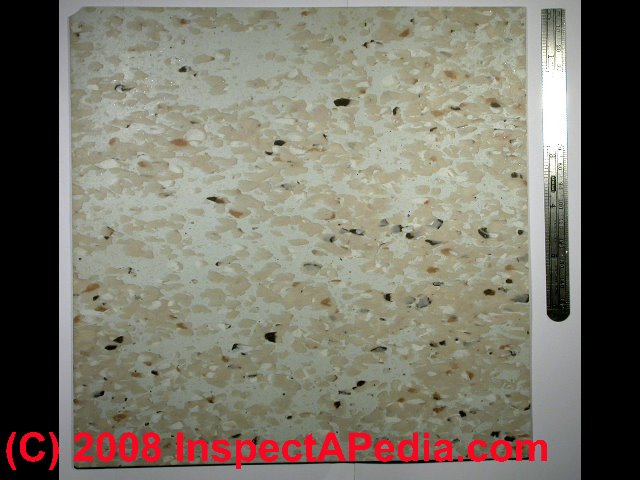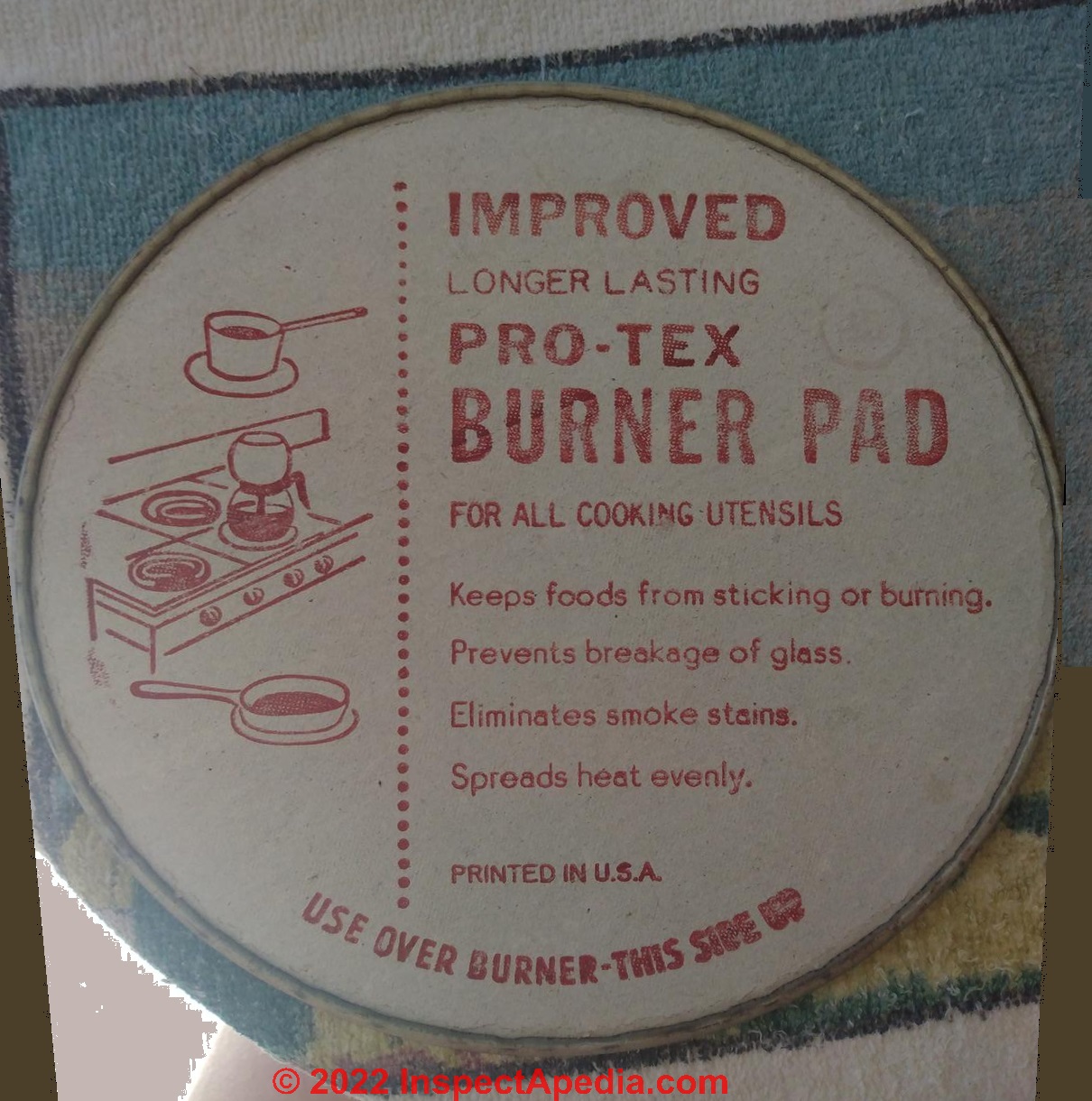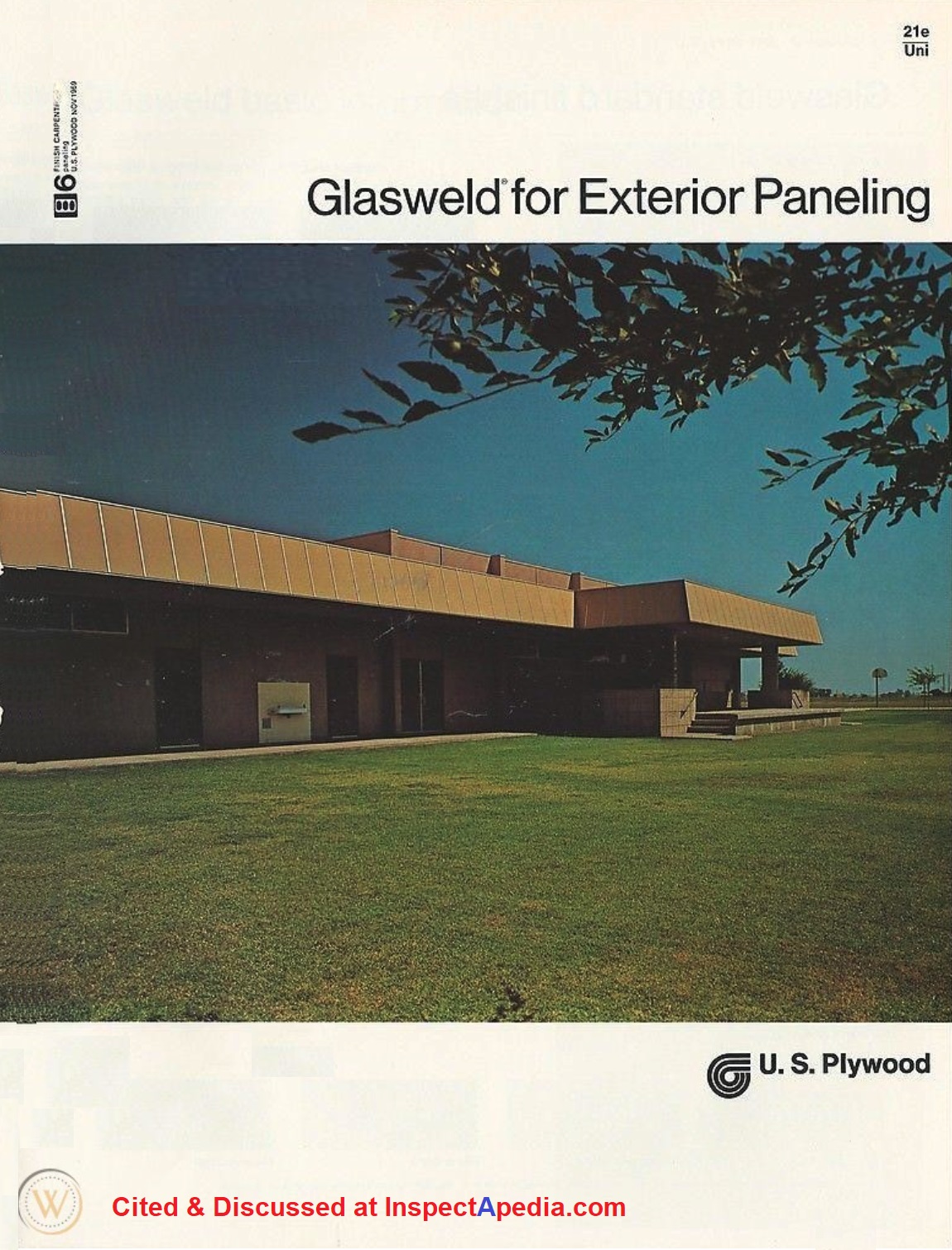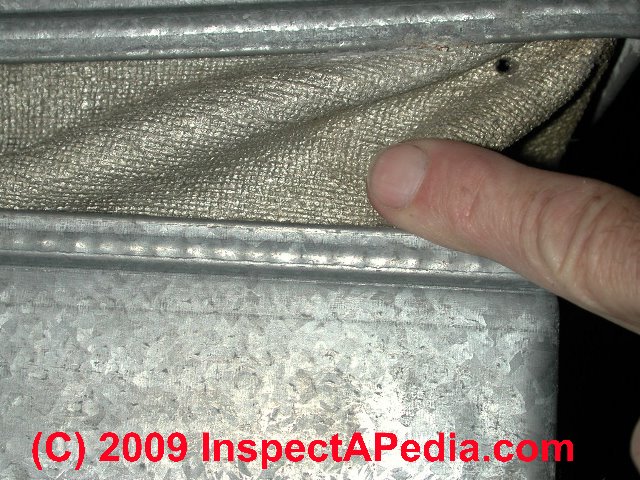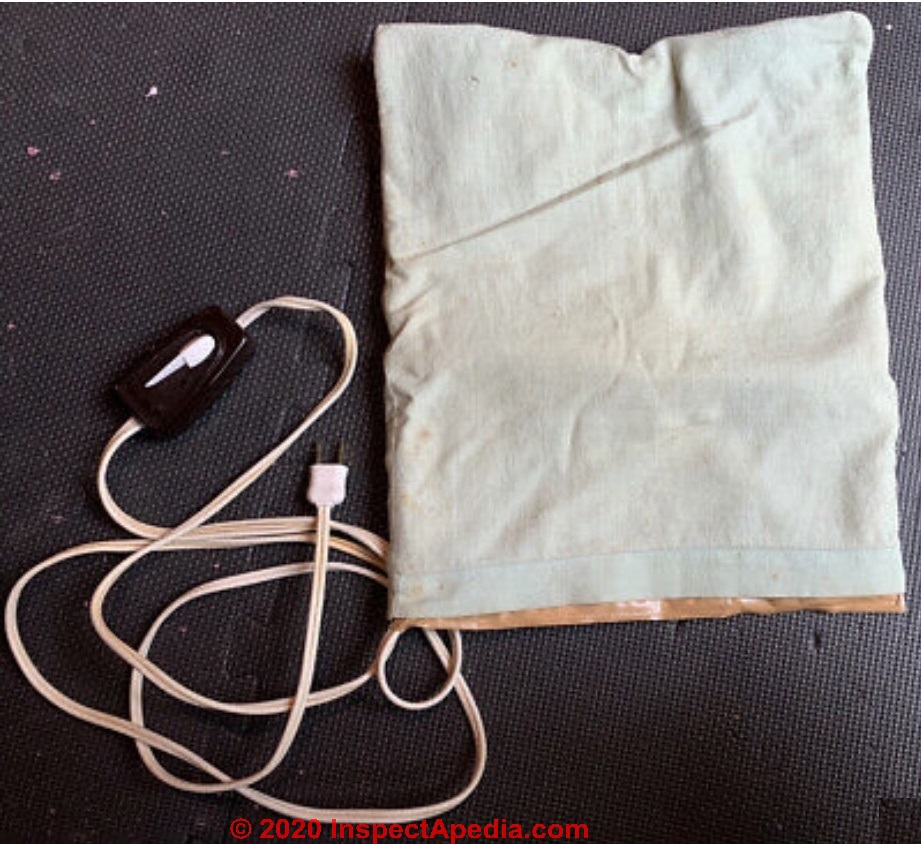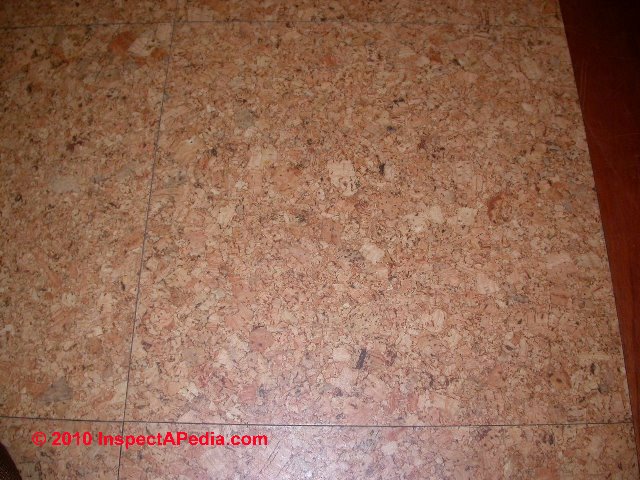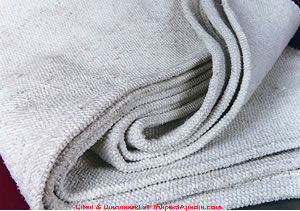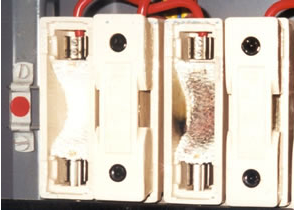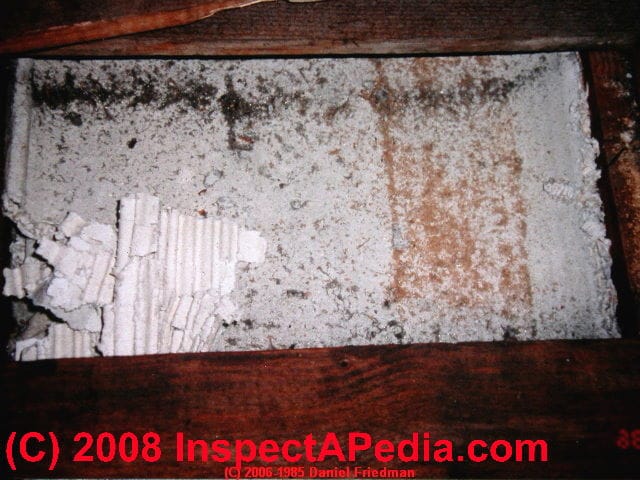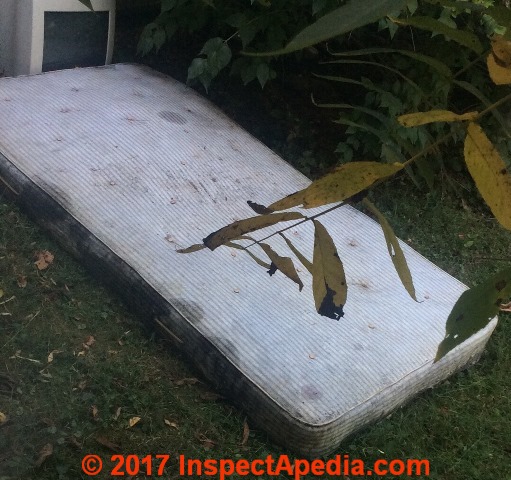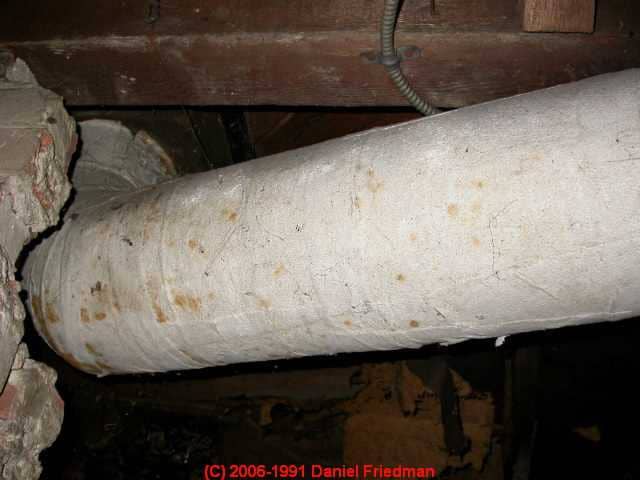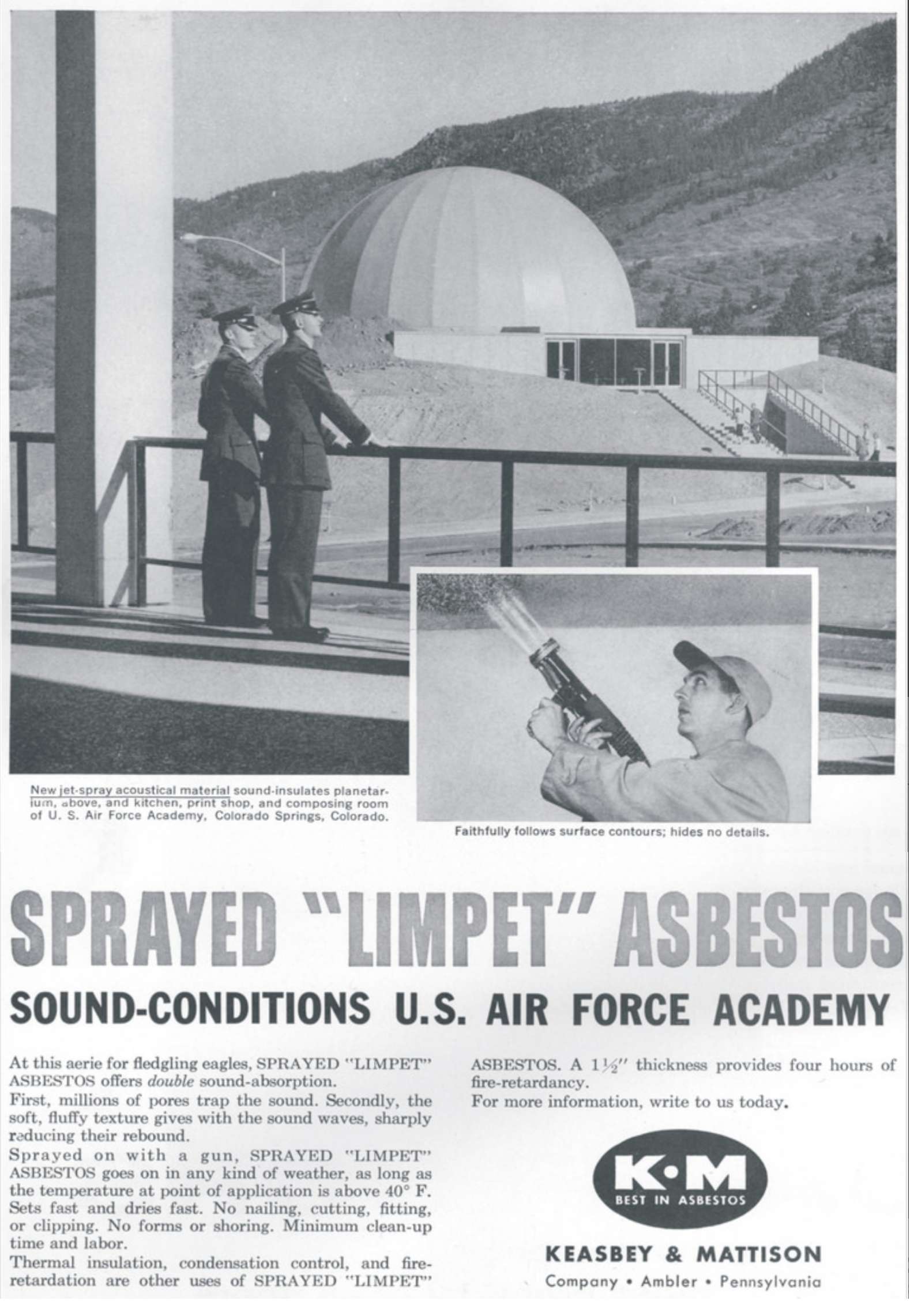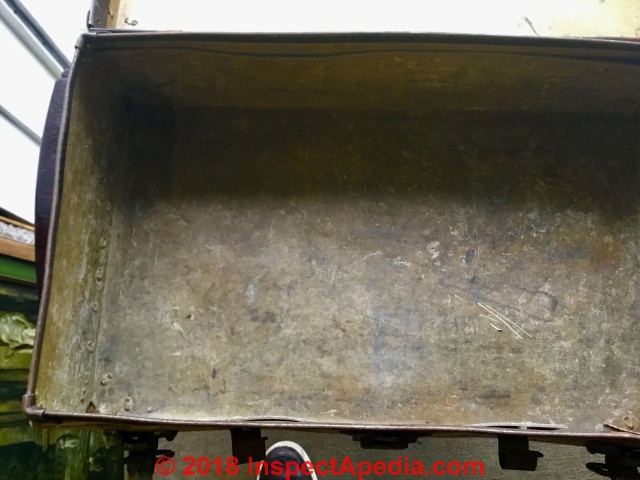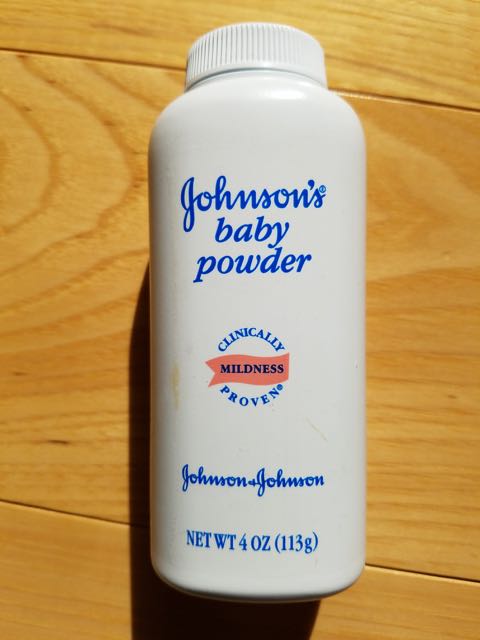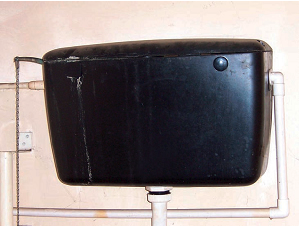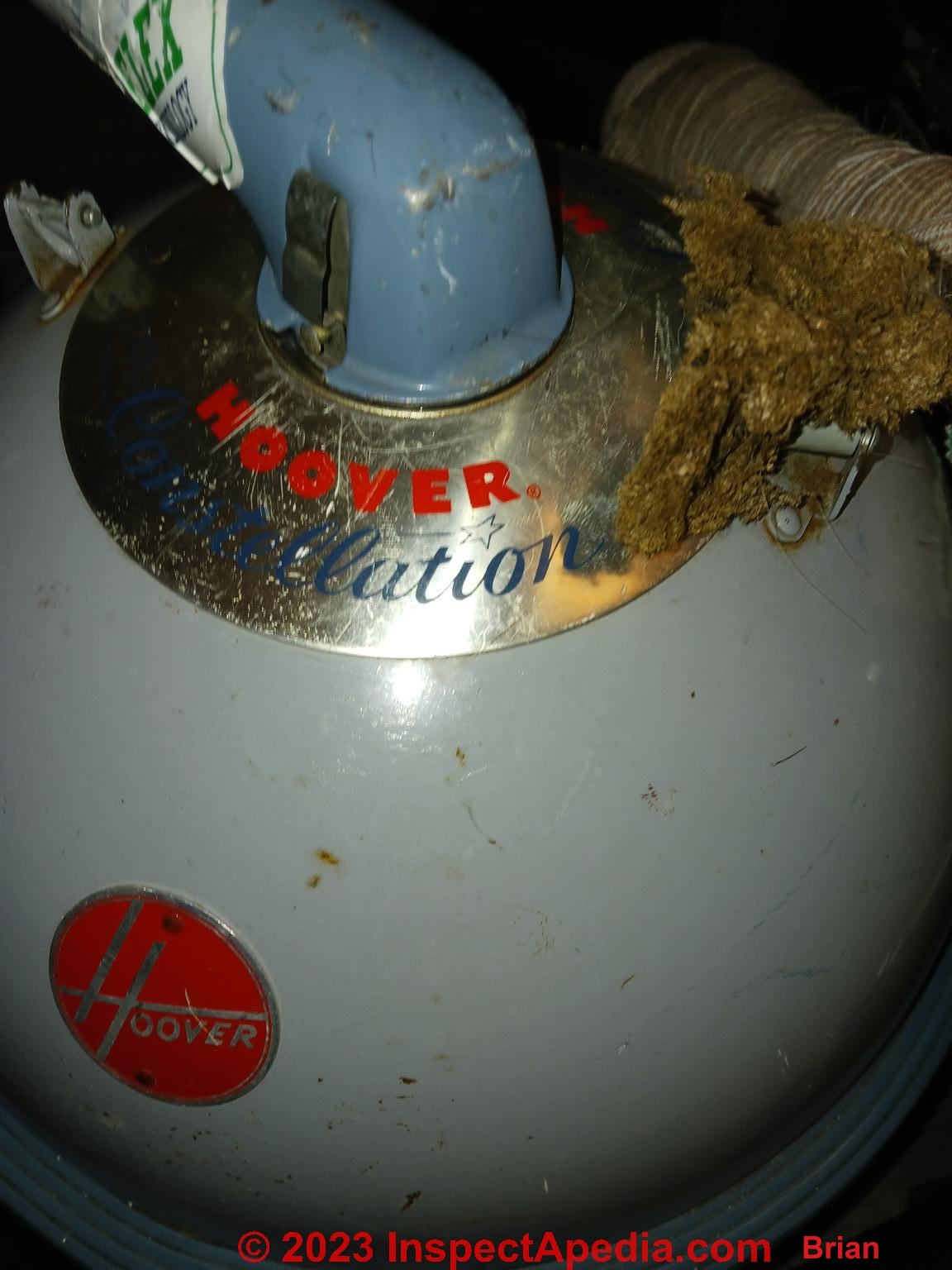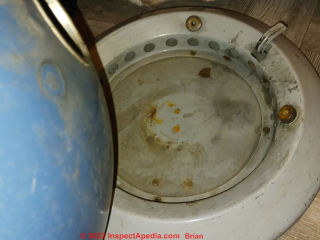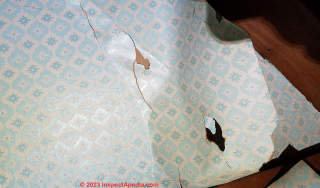 Asbestos Forms & Asbestos-containing Products
& Companies
Asbestos Forms & Asbestos-containing Products
& Companies
Complete list of asbestos containing products
- POST a QUESTION or COMMENT about what building products and common in-building products, appliances, mechanical components were produced using asbestos materials
Asbestos products & applications:
Common forms in which asbestos was used in building materials & products.
This article provides a master list of the forms in which asbestos was used, a list of known asbestos-containing materials, and links to detailed articles about individual asbestos-containing products & materials found in buildings and in a wide range of products used in both home and industry.
Page top photo: asbestos widely used as braided or woven rope type packings, gaskets, seals.
This document assists building buyers, owners or inspectors who need to identify asbestos materials (or probable-asbestos) in buildings by simple visual inspection.
We provide photographs of asbestos containing materials and descriptive text of asbestos insulation and other asbestos-containing products to permit identification of definite, probable, or possible asbestos materials in buildings.
Asbestos is safe and legal to remain in homes or public buildings as long as the asbestos materials are in good condition and the asbestos can not be released into the air.
InspectAPedia tolerates no conflicts of interest. We have no relationship with advertisers, products, or services discussed at this website.
- Daniel Friedman, Publisher/Editor/Author - See WHO ARE WE?
Master List of Asbestos-Containing Products & Materials: of Forms, Products, & Substances Containing Asbestos
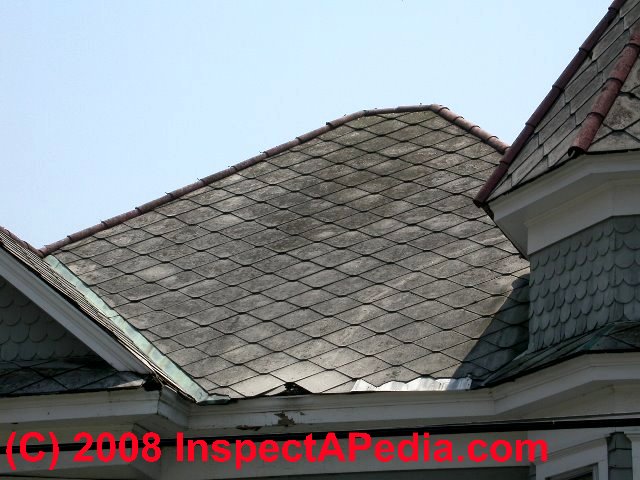
Here we provide a master list of manufactured products that contain asbestos. Our list of asbestos-containing materials is sorted by alphabetically by product or use.
How to search this list of asbestos products:
Use your browser's CTR-F (PC) or CMD-F (Mac) to search this page for any asbestos keyword.
Contact us by posting a question or comment at the end of this page if you cannot find information you need.
Photo above: asbestos cement roof shingles (tiles) on a home in Newburgh, New York, photograph by D Friedman.
Classes of Asbestos Use
Asbestos uses was classed by Lindell (1973) into thirteen classes including
(i) insulation or filler; (ii) blocks and pipe sections;
(iii) gaskets and packing; (iv) cement sheets and paper;
(v) textiles; (vi) blankets or felts; (vii) friction materials (e.g., brakes); See details about the use of asbestos in brakes, brake linings, brake pads
at ASBESTOS FRICTION MATERIALS
(viii) consumer products like Bakelite, used for knobs on furnaces and other hot objects, radios, TVs, and other electrical applications;
(ix) flooring; (x) pipe; (xi) home siding; (xii) joint compound; and
(xiii) other heat-resistant materials, such as coatings, mastics, welding blankets, and gloves.
Examples of all of those products and links to more detail are given below on this page.
Range of Asbestos-Containing Products
The actual range of asbestos-containing products and materials is enormous and no categorization, including that by Lindell is all-inclusive. As those authors point out, during World War II, for example, asbestos was used in hundreds (I suspect more) of applications in U.S. Navy ships alone. (Rushworth 2005) and US battleships such as the USS Iowa carried about 465 tons of asbestos just as thermal insulation alone.
As just one example, nowhere in Lindell's thirteen classes of asbestos use do other widespread uses appear, including the use of asbestos in filters used in applications from apple cider to medical uses to wine-making as early as 1900. (Alwood 1903).
By the 1980's in the U.S.the dominant uses of asbestos had shifted to the construction industry and industrial products in a stunning range of items.
While this is the most extensive list of asbestos-containing products & materials available, it is of course incomplete, as asbestos was used in thousands of products and materials and is still used in many. CONTACT US to add items and photographs to this list of asbestos containing materials.
In addition to our continued additions to this list of asbestos-bearing items, asbestos may be present in still other substances and even products, not by its deliberate use or design, but because it occurs naturally, such as asbestos that is found in some talc powders (amphibole asbestos).
This article is a companion
to ASBESTOS PRODUCING COMPANIES & TRUSTS where we list known producers of asbestos-containing products and where possible we include a list of the asbestos-containing products produced by each company.
Common asbestos-containing building materials are illustrated separately
at ASBESTOS PHOTO GUIDE to MATERIALS our extensive photo library.
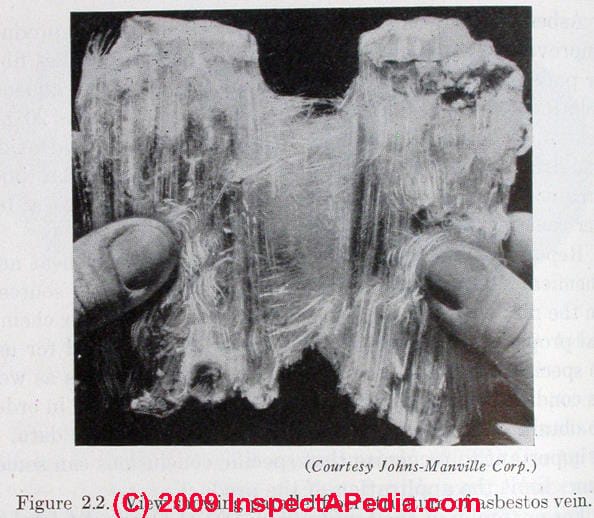 Asbestos in many forms was discontinued in all home construction uses beginning in 1990,
Asbestos in many forms was discontinued in all home construction uses beginning in 1990,
but beware: pre-1990 products might have been used in some homes built shortly afterwards. And asbestos continues to be released into the environment, though at lower levels than previously.
According to the US EPA Toxics Release
Inventory, total releases of friable asbestos to the
environment (includes air, water, and soil) in
1999 were 13.6 million pounds from 86 facilities
that reported producing, processing, or using
asbestos (ATSDR, 2001).
In 2009, total releases
of 8.9 million pounds of friable asbestos were
reported by 38 facilities (US EPA, 2010). - ASBESTOS report from IARC NCBI U.S. NIH (2012) cited atReferences or Citations
Low asbestos risk in some materials:
One should note that some of these products contain such small amounts of asbestos, or asbestos in forms not easily converted to airborne fibers (non-friable), that the risk from the product is likely to be very small.
One might elect to dispose of an old asbestos-containing toaster, but not to hire an environmental test firm or asbestos abatement company for that procedure.
Many other asbestos-containing products, both historic and among some current products, encapsulate the asbestos fibers in cementious or resinous materials which minimize the possible release of asbestos fibers into the air.
Note: most of the uses of asbestos listed here are obsolete
and the products mentioned have not been manufactured for quite some time. However these
products may still be encountered, particularly in older buildings and among old consumer products.
However some current materials may contain and are permitted to contain asbestos.
In May 1999 Asbestos Materials Bans Clarification was issued by the U.S. EPA clarified that there are some
categories of asbestos-containing products that are NOT subject to a ban.
For example, the Asbestos National Emission Standards for Hazardous Air Pollutants, or NESHAP) rules issued in November, 1990 prohibits spray-on application of materials containing more than 1% asbestos to buildings, structures, pipes, and conduits unless the material is encapsulated with a bituminous or resinous binder during spraying and the materials are not friable after drying. [Italics inserted by -DF].
Thanks to Susan Kimball, Argus Pacific, for this clarification. See ASBESTOS REGULATION UPDATE for details.
Forms & Products in Which Asbestos Was Used - alphabetical list
Asbestos was used in both its long fiber form (photo above, Rosato (cited atReferences or Citations , courtesy J. Mansville), woven into cloths, for example, and in
an ASBESTOS POWDER FORM [image] as
a FILLER in FLOOR TILES [image].
These classes of asbestos fibers vary widely in size and also, depending upon the matrix of bonding or adhesive material and the mix of asbestos with other materials, the friability and release of asbestos particles from various materials varies very widely from probably below detection, to very great.
It is also useful to understand that the form in which asbestos was used ranged among a number of forms.
The list below (adapted and expanded from the nearly-complete asbestos product list found in Rosato) lists forms of asbestos-containing products.
- Asbestos in Abrasives - including asbestos abrasive wheels or abrasive compounds and polishing compounds are discussed
at ASBESTOS OTHER PRODUCTS - Asbestos in Accelerator Pedals (automobiles, trucks),
O.C. Ritz Woller, "Accelerator Pedal", U.S. Patent No. 1,875,399, Granted: 06 September 1932,
Excerpt: The asbestos sheet 19 interposed between the plate 10 and the rubber tread serves to protect the drivers foot from the heat of the engine - Asbestos acoustical spray coating
- Asbestos in Adhesives - floor tile mastic, tile mastic, ceramic tile adhesive
See details of asbestos-adhesives
at ASBESTOS OTHER PRODUCTS Asbestos was used in mastic adhesives for flooring, ceilings, and in roofing cement or flashing cement as well as other adhesive products. - Asbestos Acoustical Ceiling Tiles
- Asbestos Acoustical Coatings - sprayed
- Asbestos in air conditioners & air conditioning systems & air handlers
Asbestos was used in air conditioning systems including air conditioner air handlers, ductwork, filters, duct vibration dampeners, and as constituents in some wall and window A/C units.
For details see
ASBESTOS in AIR CONDITIONERS
ASBESTOS DUCT DAMPENERS
ASBESTOS DUCTS, HVAC
TRANSITE ASBESTOS CHIMNEYS, DUCTS, PIPES - Asbestos in aircraft components & parts, including drop tanks, is described
at ASBESTOS in PLASTICS while
asbestos in other aircraft components such as wiring [OPINION] are covered under
ASBESTOS ELECTRICAL INSULATION - Asbestos in aerial distress flares
- Asbestos in automobile parts: panels, brakes, wire looms, undercoating, gaskets, mufflers, muffler guards, muffler repair compound
- Asbestos in auto body filler compound
- Asbestos barbeque bed liners
- Asbestos in Blankets: asbestos was used in fire blankets, welding blankets, and might be found on electric blanket wiring insulation;
see details at ASBESTOS in BLANKETS ( Decription of used of asbestos in Bedding blankets , Electric Blankets, & Fire blankets)
Asbestos boat hull repair kits - Asbestos in Bonding Adhesives - as a strengthening additive
Asbestos air duct sealant cement
see ASBESTOS OTHER PRODUCTS
Asbestos was also used in bonding adhesives used in bond joints including for a bicycle frame. Details are
at BICYCLE ASBESTOS USES
- Asbestos in apple cider making - the Asbestos sack filter or Filtre Maignen and an asbestos gravity filter were described in 1903
Details are at Asbestos in Filters are discussed in detail
at ASBESTOS FILTERS
Excerpt: Asbestos sack filter. The French use a filter (fig. 25) which they claim will remove all insoluble matters from the fresh must, and leave it clear and limpid as it goes into the cask. No demonstration of this was seen, but this filter (Filtre Maignen) is much used in France, and appears to be a good, cheap filter.
It is made from asbestos. A fairly closely woven asbestos sack, 10 or 12 inches in diameter and of any desired length, is tied tightly at one end; then in the bottom of this is placed an openwork disk, and a string is tied above the same so as to nearly draw the sides of the sack together; above this is placed a second disk; and so on until the filter sack is filled. ... - Alwood, William Bradford. "STUDY OF CIDER MAKING IN FRANCE, GERMANY, AND ENGLAND WITH COMMENTS AND COMPARISONS ON AMERICAN WORK." (1903) [PDF] retrieved 2018/08/13, original source: https://ia802606.us.archive.org/26/items/studyofcidermaki00alworich/studyofcidermaki00alworich.pdf
- Asbestos in Appliances - was widely used in many gas & electrical appliances as a heat shield and sometimes as a structural component;
Cookstoves (Moffatt and others), irons & iron rests, toasters, electric heaters, refrigerators, coolers, broilers, deep fryers, popcorn poppers, ranges, ovens, clothes washers, clothes dryers, dishwashers.
Other household items used in the kitchen such as pot holders used asbestos fabrics.
Details about appliances that used asbestos will be found at
- Asbestos in appliances such as air conditioners, dishwashers, mixers, portable electric heaters, popcorn poppers, refrigerators, toasters, ovens, stovetops, vacuum cleaners, waffle irons,
- ASBESTOS USE in APPLIANCES such as refrigerators, irons, toasters - Asbestos in dryers, clothes dryers
- ASBESTOS in CLOTHES DRYERS - Asbestos was also used in gasket materials that may have appeared in some appliances:
Question: Did the old 1927 GE monitor top refrigerator have asbestos?
(Mar 11, 2018) Alyssa said: Did the old 1927 GE monitor top refrigerator have asbestos?
Reply:
Possibly, but my research did not find any mention of asbestos in the description of the GE monitor-top refrigerators. The GE Monitor Top refrigerator was a major product development for General Electric and was widely sold and is still recognized world-wide.See the ASBESTOS IN APPLIANCES live link given just above.
- Asbestos in appliances such as air conditioners, dishwashers, mixers, portable electric heaters, popcorn poppers, refrigerators, toasters, ovens, stovetops, vacuum cleaners, waffle irons,
- Asbestos Asphalt floor tiles contained asbestos as well as later-manufactured vinyl floor tiles. The date of cessation of asbestos use in flooring varies by country and product.
See ASBESTOS FLOORING IDENTIFICATION - Asbestos Automobile bodies
and railway sleepers (molded composition)- (we also find cement ASBESTOS MILLBOARD used in vehicles)
- Asbestos used as molded automotive body parts is discussed
at ASBESTOS in PLASTICS - Asbestos Automotive body undercoating -
see ASBESTOS OTHER PRODUCTS
- Asbestos in Beverages & Asbestos in Beer & Wine
Bowler, J. M., and TATSUJI HAMADA. "Late Quaternary stratigraphy and radiocarbon chronology of water level fluctuations in Lake Keilambete, Victoria." Nature 232, no. 5309 (1971): 330.
Excerpt:
Fig. 1 Electron micrograph of asbestos fibre isolated from beer (enlarged 31,000 times). The asbestos fibres in 400 ml ...
Cunningham, H. M., and R. D. Pontefract. "Asbestos fibres in beverages and drinking water." Nature 232, no. 5309 (1971): 332.
Excerpt:
Asbestos fibres have already been found in beer 12 , and the occurrence of fibres 0.5 nm in length and 0.01 nm in diameter suggests that such material may find its way through filtering systems into city drinking water supplies
Durham, Ray Wilson, and T. Pang. "Asbestos fibers in Lake Superior." In Water Quality Parameters. ASTM International, 1975.
Excerpt:
These fibers were expected to have come from the chrysotile asbestos filters used in beer production.
Glenister, Paul R. "Applications of optical staining in the examination of beer sediment." In Proceedings. Annual meeting-American Society of Brewing Chemists, vol. 29, no. 1, pp. 192-199. Taylor & Francis, 1971.
Excerpt:
Asbestos particles in beer sediments may also he detected with a polarizing microscope using partially or completely crossed polarizing elements
Pontefract, R. D., and H. M. Cunningham. "Penetration of asbestos through the digestive tract of rats." Nature 243, no. 5406 (1973): 352.
Excerpt:
We have shown 4 that asbestos fibres are present in drinking water, beer, wine and other beverages. - Asbestos in Bicycle Seats - used from 1898 to 1971 or later.
See BICYCLE ASBESTOS USES for details about the use of asbestos in bicycle saddles or seats, brakes, frames, tires.
- Asbestos Boiler insulation - hardcast or asbestos paste applied to hot water or steam boilers as well as to piping elbows.
See ASBESTOS BOILER INSULATION
- Asbestos in Books & Bookbinding
- asbestos was used in the production of fire-resistant or "fireproof" books, journals, ledgers. We did not find patents or other articles describing the use of asbestos in ordinary reading books for adults or children. (Researched Google Patents 2017/11/20)
See details now moved to ASBESTOS BOOKS & BOOKBINDING
- Asbestos Brakes & Brake Pads or Brake Linings - Molded lining and blocks, predominantly Chrysotile asbestos
Question: was asbestos used in exercise bike friction pads?
2018/03/22 Justin S said:
Does anyone know if asbestos was used in Exercise Bike Friction Pads in the 1970's or 80's. The one we have has a stiff felt like material. -
Reply: yes
Yes, Justin, some exercise bikes used asbestos in their pads, as we find in some patent disclosures. I include two examples below, from 1981 and 1989.
Disbrow, Richard A., and Russel O. Blanchard. "Exercise equipment." U.S. Patent 4,305,578, issued December 15, 1981.
"...preferably, pad 50 is made of an impregnated asbestos material "Disbrow, Richard A., and Russel O. Blanchard. "Unobstructed adjustable V-frame exercycle." U.S. Patent 4,811,945, issued March 14, 1989.
"... Preferably, pad 50 is made of an impregnated asbestos material …'
See details about the use of asbestos in brakes, brake linings, brake pads
at ASBESTOS FRICTION MATERIALSIn any event you can minimize any potential hazard by avoiding using compressed air to clean the brakes on your exercise bike.
- Asbestos Bulbs, Light bulbs, lamps is discussed
at ASBESTOS in UNUSUAL PLACES and
LIGHT BULB ASBESTOS USE
- Asbestos stove burner pads & hot pads - used as hot pads, trivets, utensil pad, to prevent cracking or breaking of hot glass (photo above, courtesy of InspectApedia.com reader Pamela 2022/03/05
Question: Are vintage Pro-tex asbestos burner pads safe for use today?
Are vintage pro-tex asbestos burner pads safe for use today? - Pamela 2022/03/05 posted originally at ASBESTOS PRODUCT FAQs-3 - https://inspectapedia.com/hazmat/Asbestos-Containing-Products-FAQs3.php
Moderator reply:
@Pamela,
The 8 1/2" diameter Pro-Tex burner pad was made of asbestos material with an outer metal ring. It was popularly described as a "fireproof stovetop pad" for use between the burner and metal or glass and also as a hot pad or trivet.
And indeed the illustration shows the pad being used both atop a burner to allow heating of a glass coffee pot as well as for use as a trivet or protective pad on a tabletop beneath a small frying pan.
Produced in the U.S. by the Pro-Tex, Ballonoff Metal Products Company, 5817 Kinsman Road, Cleveland, Ohio, from at least 1938.
(Sometimes spelled Ballanoff Metal Products, and the inventor's name mis-spelled also as Ballonol, but the correct spelling is Irv Ballonoff. - Ed.)
The Pro-Tex line of asbestos-based protective pads was still in wide-use in the 1960s. Your round asbestos-based stove burner pad is described by the Smithsonian Institute as
Circular asbestos “Burner Pad” with aluminum-plated sheet iron backing and outer ring.
White, printed in red: “FOR METAL OR/GLASS UTENSILS/PRO-TEX/BURNER PAD/PREVENTS BREAKAGE OF GLASS/KEEPS FOODS FROM/STICKING OR BURNING/FIREPROOF ASBESTOS/PRINTED IN U.S.A./USE OVER FLAME-THIS SIDE UP”
with image of pots, coffee maker and stove top. - source: Smithsonian Institute, retrieved 2022/03/05 original source: www.si.edu/object/nmah_1100760
Gas Appliance Merchandising, Vols. 9-10, April 1937, p. 31 described as "new" a large rectangular asbestos board pads 18x12" or 16x18" - above. (Ballinol company also sold chrome stove pipes and accessories. ) In 1938 the company announced new sizes of their rectangular protective pad and described the product as
The Pro-Tex pad is a heavy asbestos board, topped with gleaming metal. It comes in two finishes: Satin stripe nickel plated, and serviceable crimped pattern. Dealers report that customers appreciate the insulating quality of the pads which keep plates and dishes on range tops from becoming too hot. Also described as a table top pad and as a "Brite" pad depending on finish and materials.
The round Pro-Tex burner pad in your photo was introduced later and was sold widely in the U.S. and used not only in home kitchens but also in school chemistry labs. (School Safety, Vols. 1-4 -. 21 1965).
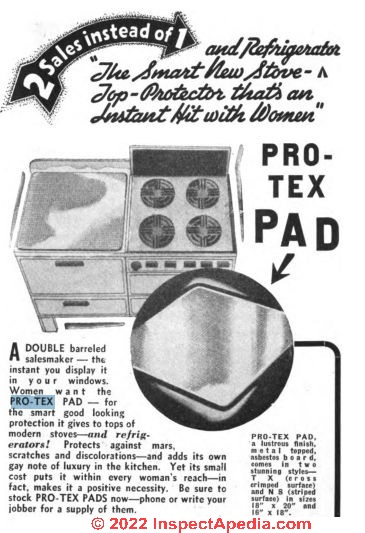
Thanks for the round "Improved" Pro-Tex burner pad photo, we have added it to our master list of asbestos-containing products found at
ASBESTOS LIST of PRODUCTS - topic home
PLEASE post a better photo of your asbestos pad, to include the entire object. - Thanks, Mod.
Irv, Ballonoff. INSULATING PAD [PDF] U.S. Patent 2,739,412, issued March 27, 1956.
Excerpt:
The primary object of the invention is the provision of insulating mats and pads constructed to include as base board a double-backed air cell or corrugated board lined at the rear face with a layer of asbestos and formed with an eyelet hole lined by a grommet engaged with its one flange with the layer of asbestos and its other flange with the corrugated board in a recessed area thereof, and a cover member overlying the baseboard and its grommet formed by a sheet of metal turned with its edges over the edge of the baseboard and lapped under same to secure the sheet of metal and the baseboard to each other.
On 2019-03-28 by (mod) - asbestos fabric hot pad that is intact and un-damaged
Kim in my OPINION an asbestos fabric hot pad that is intact and un-damaged probably does not shed measurable levels of asbestos into the building air as long as the pad is not being abused or handled roughly.
But frankly, unless you want to preserve your Pro-Tex Fire Burner asbestos hot pad as a museum piece (the Smithsonian already has one of these). given consumer worries and the inability for anybody sitting at a remote site in Mexico trying to help our readers with questions like this, I'm forced to also suggest that considering the costs involved it'd make sense to dispose of the hot pad and replace it with a modern one.
In its current incarnation, probably a different company, Protex can be contacted at Protex Supply 2544 Tarpley Rd, Ste. 106, Carrollton, TX 75006, US Office(972) 695-6350 After Hours (214) 929-9979On 2019-03-20 by Kim - info on vintage Pro-Tex Fire Burner asbestos hot pads to determine if they are safe for use.
Hello, I am searching for info on vintage asbestos hot pads to determine if they are safe for use.
I have an old family one that is a "Pro-tex Fire Burner". Your Master index indicates that yes, it was used for such things.
The surface is intact, but I don't know if that constitutes safety. Can you advise? Thank you! - Asbestos used in bricks is discussed
at ASBESTOS in BRICKS or MORTAR and properties of asbestos-containing bricks is also cited
at ASBESTOS OTHER PRODUCTS
- Asbestos in batteries - Asbestos Insulation of batteries (loose fiber)
- Asbestos base flashing
- Asbestos blankets: asbestos was used in fire-smothering blankets or ie asbestos fire-smothering blankets
see ASBESTOS FIRE BLANKETS
- Asbestos buffing compound
- Asbestos boiler insulation, applied as a thick paste as well as used in corrugated paper sheeting
See ASBESTOS BOILER INSULATION - Asbestos breeching insulation
- Asbestos Carpeting: asbestos used in carpets & carpet padding -
see ASBESTOS in CARPETING, PADDING - Asbestos in caulks & sealants & putties is described as asbestos caulking products including sealants and also asbestos ropes and gaskets
at ASBESTOS OTHER PRODUCTS. - Asbestos cement pipes used in water supply mains
See TRANSITE ASBESTOS CHIMNEYS, DUCTS, PIPES
Also see ASBESTOS CEMENT PRODUCTS.
Above: Glasweld® mineral-granule-coated asbestos cement board was produced by U.S. Plywood and intended for use as exterior wall panels in the 1970s. Another brand was QASAL Glasweld and Glasweld® Miawal "High Performance Interior Walls (shown below from a 1977 catalog for sale on eBay in 2022) was sold in 23 different colors and in panels of various sizes. Mirawal was also sold as a chalkboard "writing panels" for classroom use. So yes there were indeed asbestos-cement "blackboards" or "chalkboards".
- Asbestos cement panels, sheets, boards, transite panels produced in North American as early as 1907 and extending to about 1985.
Asbestos cement panels or boards were produced in several thicknesses and in flat smooth as well as corrugated panels used as roofing, siding, fire-proofing in boiler rooms, in cooling towers, and in numerous other applications. These hard-surfaced products were sufficiently weather-resistant to be used outdoors.
These products were also marketed as "asbestos lumber"
See CEMENT ASBESTOS SHEET PRODUCTS for details.
See ASBESTOS PRODUCING COMPANIES & TRUSTS to find companies producing asbestos cement boards & panels. Search also for Glasweld.
- Asbestos in ceramic tile -
see CERAMIC TILE, ASBESTOS / LEAD?
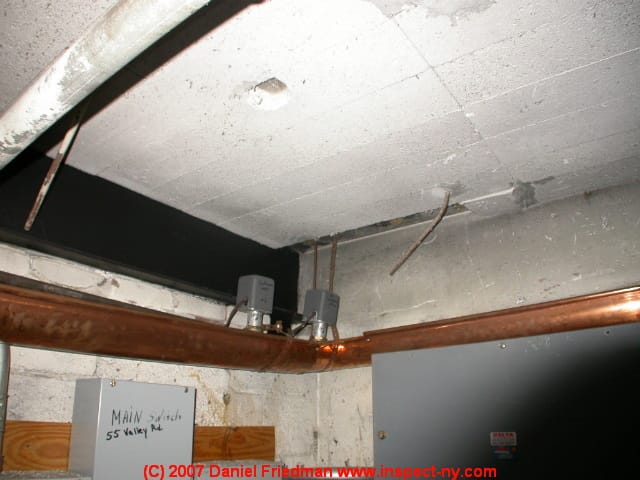
- Asbestos Ceilings & Ceiling Tiles: Transite cement panels were also sued for countertops and to form fire resistant wall and ceiling cladding such as in factories, shops, and heating or mechanical rooms.
Asbestos fibers were used in some acoustic asbestos ceiling tiles, often amphibole asbestos such as amosite, crocidolite, anthrophylite, teremolite, and actinolite, with amosite among the most commonly-found. - see
Details about ceiling tiles & suspended ceilings including those that may contain asbestos are found
at CEILING TILES - Asbestos-Containing where brands of ceiling tiles and suspended or drop ceiling tile products that contain asbestos are listed.
Also see ASBESTOS CEILING TILE FAQs that includes research citations on asbestos content in various ceiling tile products including some wood fiber materials.
Also see CELOTEX ASBESTOS PRODUCTS.
Also see SHEATHING, FIBERBOARD ASBESTOS CONTENT that includes discussion of asbestos content in Nu-Wood products from the Wood Conversion Company (Conwed) and others.
Because some ceilings were covered with a cement-asbestos products, also
see ASBESTOS CEMENT SIDING.
Our photo (left) illustrates the use of near-pure tremolite asbestos tiles as fireproofing in the basement utility room of a building we inspected in White Plains, NY around 2005.
The tremolite asbestos ceiling fireproofing panels shown above were 3/4" thick. We describe this product in detail
at ASBESTOS FIREPROOFING
A thinner cementious material, typically less than 1/4' thick, asbestos cement millboard was used as a covering for ceilings over boilers, furnaces, water heaters, smoke stacks, etc. for fire protection - discussed
and
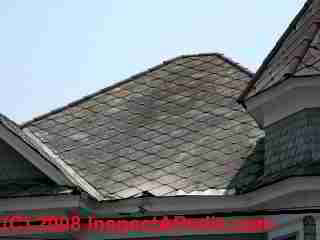
- Asbestos-cement products, flat sheets, wallboard, such as in siding and roofing products
Details about this product category are
at ASBESTOS CEMENT PRODUCTS
- Asbestos cement blackboards or chalkboards
- Asbestos cement materials used in interior sheathing of factories, refrigeration rooms, etc.
- Asbestos cement materials used in wall partitions, movable and fixed
- Asbestos cement materials used in brick type siding
- Asbestos cement materials used in roofs and sides of small buildings (and large ones)
ASBESTOS CEMENT & FIBER CEMENT SIDING
and ASBESTOS & FIBER CEMENT ROOFING - Asbestos cement materials used in fireproof layer on insulated board
- Asbestos cement materials used in lining of fireless cookers
- Asbestos cement materials used in shoes for elevators and automobiles, ASBESTOS BRAKE PADS
- Asbestos cement materials used in mounting of test instruments and gauges
- Asbestos cement materials used in switch boards
- Asbestos cement materials used in insulators between phases on arc deflectors
- Asbestos cement materials used in electric motor casings
- Asbestos cement materials used in lining for bleaching and other tanks and vats
- Asbestos cement materials used in blackout or bombproof board
- Asbestos cement materials used in exterior building sheathing, asbestos cement shingles, asbestos cement sheets, asbestos cement boards, including half-timber effect
- Asbestos cement materials used in portable buildings
- Asbestos cement materials used in semi portable motion picture booths
- Asbestos cement materials used in fire protection around engines
- Asbestos cement materials used in backing for dies in molded glass
- Asbestos cement materials used in hoods over machines or vats from which vapor rises
- Asbestos cement materials used in cabinets and panel box work
- Asbestos cement materials used in miscellaneous electrical apparatus
- Asbestos cement materials used in spark arresters
- Asbestos cement materials used in backgrounds and cutouts for window displays
- Asbestos cement materials used to insulate heating and water piping joints and elbows -
see ASBESTOS PIPE INSULATION - Asbestos cement pipe: transite pipe, cement asbestos pipe for water & sewer distribution, chimneys vents, ductwork
- Asbestos cement used to produce various types of piping for water, vent piping, and HVAC ducts -
see TRANSITE PIPE AIR DUCT ASBESTOS RISKS
TRANSITE PIPE CHIMNEYS & FLUES
TRANSITE PIPE WATER SUPPLY PIPING - ASBESTOS MILLBOARD or asbestos cement sheet products used as roofing, siding, heat shielding, welding shields, baking pads
- Asbestos cement table tops, lab tables
- Asbestos cement vault liners
- Asbestos cement pipes were used in these applications:
- Asbestos cement pipes used for carrying water, sewage, gas, and special liquids
- Asbestos cement pipes used for gas vent pipes such as plumbing vents
- Asbestos cement pipes used for conduits for electric light wires
- Asbestos cement pipes used for purlins, rafters, etc. for wartime buildings
- Asbestos [added by DF]: air ducts in buildings, often in floor slabs
- Asbestos [added by DF]: gas heating or hot water heating appliance chimneys and flues
- TRANSITE PIPE AIR DUCT ASBESTOS RISKS
- TRANSITE PIPE CHIMNEYS / FLUES
- TRANSITE PIPE WATER SUPPLY
Transite cement panels were also sued for countertops and to form fire resistant wall and ceiling cladding such as in factories, shops, and heating or mechanical rooms. - See ASBESTOS CEMENT SIDING
Also see CAREY SIDING CATALOG 1950 [PDF] Ceramo ceramic-glazed asbestos-cement siding
- Asbestos chalkboards: asbestos was used in chalkboards used in schools and other locations
Asbestos and asbestos-containing talc were also ingredients in marking chalk itself. - Asbestos in chicken coops, hen houses & poultry brooders, in construction of chicken coops, chicken ramps, chicken partitions or separators
Roberts, William E. "Poultry brooder." U.S. Patent 2,521,480, issued September 5, 1950.
Stevens, Mary A. "Brooder." U.S. Patent 1,222,901, issued April 17, 1917.
Kumar, P. G., R. R. Churchil, A. Jalaludeen, K. Narayanankutty, L. Joseph, A. Kannan, and P. Anitha. "A survey on village chicken production in Kerala state of India." World's Poultry Science Journal 69, no. 4 (2013): 917-930.
- Asbestos in cheese making: (spores are placed on asbestos).
- Asbestos chimneys used in water supply mains -
See TRANSITE ASBESTOS CHIMNEYS, DUCTS, PIPES - Asbestos Cloth was used in products such as clothing, draperies, awnings, prison cell padding, ironing board covers, predominantly Chrysotile asbestos.
Asbestos textiles are discussed in detail
at ASBESTOS TEXTILES
See ASBESTOS FIRE BLANKETS
Also see ASBESTOS FURNITURE PADDING
- Asbestos cloth appliance wiring insulation in toasters, stoves, gas stove igniter wires, other appliance wires
- Asbestos cloth awnings - for fire-resistant window and door awning material
- Asbestos cloth candle stick holders & wraps
- Asbestos cloth catalytic heater mantles
- Asbestos cloth cigarette lighter wicks (string or fabric)
- Asbestos cloth cording & cord gaskets
- Asbestos-contaminated jute bags: asbestos was transported in jute or burlap bags that in turn would have been contaminated by asbestos dust, posing a hazard when the jute bags were recycled. Before 1964 when the asbestos industry transported asbestos in sacks the material was jute.
Later as the asbestos hazards were recognized industry shifted to use of non-porous bags of poly or plastic type materials to transport asbestos. Later the industry required impermeable bags be used for asbestos transport and that such bags, if re-used, were not to be cleaned by people (Ruers 2005).- Quinn, M. M., D. Kriebel, E. Buiatti, E. Paci, S. Sini, G. Vannucchi, and M. Zappa. "An asbestos hazard in the reprocessed textile industry." American journal of industrial medicine 11, no. 3 (1987): 255-266.
- De Zotti, Renata, and Antonio Fiorito. "A case of malignant mesothelioma in a rice-starch factory." International archives of occupational and environmental health 80, no. 8 (2007): 743-745.
- Ascoli, V., C. Carnovale-Scalzo, F. Nardi, C. Efrati, and M. Menegozzo. "A one-generation cluster of malignant mesothelioma within a family reveals exposure to asbestos-contaminated jute bags in Naples, Italy." European journal of epidemiology 18, no. 2 (2003): 171-174.
- Musk, Arthur W., Nola J. Olsen, Alison Reid, Tim Threlfall, and Nicholas H. Klerk. "Asbestos‐related disease from recycled hessian superphosphate bags in rural Western Australia." Australian and New Zealand journal of public health 30, no. 4 (2006): 312-313.
- Ruers, R. F., N. Schouten, and Socialistische Partij. "The tragedy of asbestos." Eternit and the consequences of a hundred years of asbestos cement (2005).
- Also see ASBESTOS MAIL BAGS
- Also see ASBESTOS in MATTRESSES
- Also see ASBESTOS PILLOWCASES
- Asbestos cloth mitten, gloves, fire protective clothing. Also
see ASBESTOS MACHINE GUN MITTENS
U.S Navy Filing Manual for 1941 (https://www.archives.gov/files/research/military/navy/navy-filing-manual-1941.pdf) cites use of asbestos in P2-3 Prophylaxis, Asbestos gloves, including Gloves, asbestos (preventive medicine), F49-4 Crew equipment, Asbestos clothing, F49-4, Asbestos and extra clothing, - Asbestos cloth packing, sheet, high pressure folded or wound
- Asbestos cloth Clothing, suits, gloves such as used for firefighter protection, predominantly Chrysotile asbestos
- Asbestos cloth lining, folded or stitched, also in hard fiber form such as shoes, predominantly Chrysotile asbestos -
see ASBESTOS FRICTION MATERIALS and
also see ASBESTOS BRAKE PADS - Asbestos cloth Gaskets -
see ASBESTOS PACKINGS & GASKETS - Asbestos cloth Substitute for canvas on insulation, where temperatures are high
- Asbestos cloth in Helmets, Aprons, Berets, Hangings for firestops, fire smothering blankets in electrolytic cells, mailbags
- Asbestos cloth Draperies, blankets for fire fighting, bags and diaphragms in oxygen production, predominantly Chrysotile asbestos.
See ASBESTOS TEXTILES
See ASBESTOS FIRE BLANKETS
- Asbestos cloth Awnings, asbestos theatre curtains
- Reference: Meloy, Arthur Sherman. Theatres and Motion Picture Houses: A Practical Treatise on the Proper Planning and Construction of Such Buildings,
and Containing Useful Suggestions, Rules, and Data for the Benefit of Architects, Prospective Owners, Etc. Architects' Supply & Publishing Company, 1916. - Asbestos cloth Floor lining in theaters, motion picture booths
- Asbestos cloth Acetylene welding blankets
- Asbestos cloth ductwork, flexible ducts, duct seals, duct insulation (also see Asbestos paper use on ducts) for HVAC ductwork including heating & also ventilation ducts or exhaust ducts
- Asbestos cloth faced wipers in communication
- Asbestos cloth used in filtering (fruit juices, acids, etc)
- Asbestos cloth used for HVAC duct vibration dampers, predominantly Chrysotile asbestos -
see ASBESTOS DUCT VIBRATION DAMPENERS
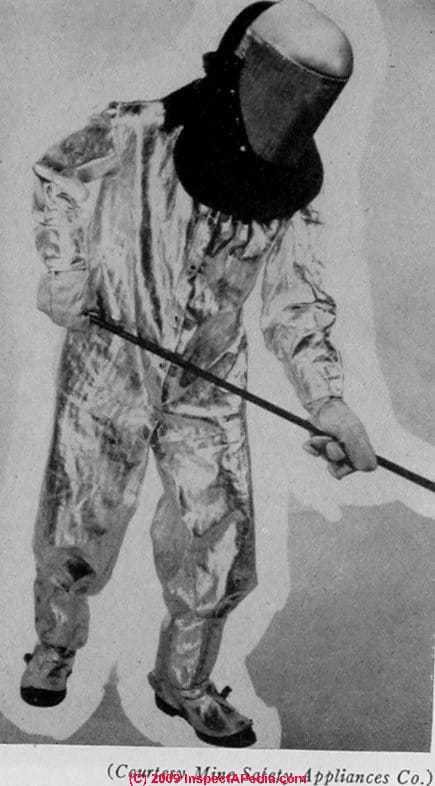
- Asbestos clothing used for fire & safety garments (image at left) - asbestos flame-resistant clothing
See
Morse, Sr Reginald A. BODY COVERING for RESISTING TEMPERATURE EXTREMES [PDF] U.S. Patent 2,335,873, issued December 7, 1943.
Robinson, Arthur G. FIRE PROTECTION SUIT [PDF] U.S. Patent 1,082,214, issued December 23, 1913. - Asbestos cloth & padding in some furniture - see ASBESTOS FURNITURE PADDING
- Asbestos cloth Oil filter sack (in automobiles)
- Asbestos cloth Oven insulation
- Asbestos cloth Lining of laboratories, cooling chambers and other rooms
- Asbestos cloth Padding prison cells
- Asbestos cloth Medical test apparatus
- Asbestos cloth Sand bags for pressing hats
- Asbestos cloth used in hay curing, to preserve aroma and color
- Asbestos cloth Insulation against noise and vibration, especially in airplanes
- Asbestos cloth ironing board covers and in pressboard covers used on larger commercial pressing machines
- Asbestos cloth lamp & asbestos cloth lantern mantles
- Asbestos pot holders & hot handle holders
Example:
Olson, Gerdon L. "Hot handle holder." U.S. Patent 1,976,411, issued October 9, 1934.
Excerpt: A heat-insulating hot handle holder cornprising a sheet of fabricated asbestos having a folded edge, a sheet of sponge rubber presenting a soft and yielding but firm gripping surface to the hand acting by its air spaces to dissipate heat, superposed on the asbestos sheet and extending within the fold of the said edge, the said asbestos sheet.
- Asbestos cloth Rugs, theater scenery
- Asbestos cloth liners in portable motion picture booths
- Asbestos cloth Acoustical treatments
- Asbestos cloth used in gun grips
- Asbestos cloth Facing for dryer felt
- Asbestos cloth felt for a wide range of uses, gaskets, pianos, organs, organ pipe stops, padding
- Asbestos cloth Filter in dust collectors
- Asbestos cloth gasket reinforcement
Photos of an antique heating pad made by Bro Lab., Inc., courtesy of an anonymous InspectApedia.com reader 2020/11/01
-
Asbestos cloth & other uses in heating pads
Asbestos was used in both the heating pad wiring, possibly in its fabric and also in the plastic body of the heating pad controls.
At least the bakelite plastic case (that may contain asbestos) of the control is not friable and if the pad is covered in a plastic or rubber-coated cloth that too, if un-damaged, is not likely to shed high levels of particles of any sort.
Asbestos was also used in the heat-generating resistance-electrical-wire insulation of some heating pads. Similarly the resistance wiring would have been inside the heating pad, not on its exterior, reducing but not eliminating that risk.
By the mid 1970s there were at least some heating pads whose inventors specifically described the elimination of asbestos in those products as an improvement, and by the mid 1980s in the U.S. asbestos would not have been used in such devices. So if your heating pad dates from before 1975 you could reasonably assume it contains asbestos.
Examples of patents citing use of asbestos in heating pads include:
Fitz, Maurice Richard J. HEATING PAD [PDF] U.S. Patent 2,240,625, issued May 6, 1941.
Knapp, Andrew S. HEATING PAD [PDF] U.S. Patent 1,967,674, issued July 24, 1934.
Youmans, Grace A. ENCASED HEATING PAD [PDF] U.S. Patent 2,675,630, issued April 20, 1954. - Asbestos cloth hose reinforcement fabric
- Asbestos cloth Protectors for gas bags in balloons
- Asbestos cloth insulation in glass fabrication & glass handling tools
- Asbestos cloth Lining in motors
- Asbestos cloth motion picture screens - movie screens
- Asbestos cloth used in plastics
- Asbestos cloth Padding for laundry presses and mangles
- Asbestos cloth tape reinforcement & pipe insulating tape
- Asbestos cloth stove gaskets & heat shields
- Asbestos cloth theatre curtains
- Asbestos cloth tent gromming reinforcement
- Asbestos cloth wire insulation e.g. (electrical wires in appliances, theatre wiring, etc. )
- Asbestos cloth Wrapping oil tanks and oil lines in engines
- Asbestos cloth Wrapping for asbestos-covered heating pipes and water piping, predominantly Chrysotile asbestos -
see ASBESTOS PIPE INSULATION - Asbestos cloth Umbrellas and shields for fire fighters
- Asbestos cloth Conveyor belting
- Asbestos cloth used in cheese making, for temperature control
- Asbestos cloth fittings for airplane
- Asbestos clothing for use in various industrial applications
- Asbestos cloth seals as high temperature gaskets
- Asbestos valve stem packing
- Asbestos coatings, paints -
ASPHALT-ASBESTOS PAINT / SEALANT
Asbestos-containing talc as well as asbestos powder and fibres were used in some paint products. - Asbestos composition materials, molded
- Asbestos Molded composition for electrical and other purposes
- Asbestos composition floor tiles (vinyl or asphalt) & sheet flooring
- Asbestos Composition material was used in these applications:
- Asbestos arc deflectors
- Asbestos-containing caulks and sealants, predominantly Chrysotile asbestos form.
- Asbestos-containing crayons (using talc as an ingredient), predominantly amphibole asbestos
See
CPSC 2000. STAFF REPORT ON ASBESTOS IN CHILDREN’S CRAYONS [PDF] U.S. Consumer Product Safety Commission August 2000. : http://www.cpsc.gov//PageFiles/97593/crayons.pdf
and see more cidtations at ASBESTOS in TALCUM POWDER - Asbestos-containing dental casts, fillers, predominantly Chrysotile asbestos
- Asbestos-containing fluids such as drilling fluids, predominantly Chrysotile asbestos
- Asbestos insulation compounds
- Asbestos fibers in acoustic asbestos ceiling tiles and fire-resistant ceilings, often amphibole asbestos such as amosite, crocidolite, anthrophylite, teremolite, and actinolite, with amosite among the most commonly-found. -
see CEILING TILES ASBESTOS CONTENT where we include photos of soft Tremolite asbestos ceiling panels. - Asbestos electric wire insulation -
see ASBESTOS ELECTRICAL WIRE INSULATION - Asbestos lamp sockets, rheostat backings, switch parts, arc deflectors, resistance mountings and other electrical products
- Asbestos underground insulation
- Asbestos phonograph records, buttons and other small objects made of plastic
- Asbestos resistance mountings and other electrical products
- Asbestos rheostat backings
- Asbestos heater cord insulation
- Asbestos missile and aircraft plastics
- Asbestos roofing products: roofing cements and flashing cements, roof coatings (tar or asphalt or bituminous coatings with asbestos fibers or fillers), flashing products - predominantly Chrysotile asbestos form.
ASBESTOS & FIBER CEMENT ROOFING - Asbestos siding products:
see ASBESTOS CEMENT & FIBER CEMENT SIDING - predominantly Chrysotile asbestos form
Also see CAREY SIDING CATALOG 1950 [PDF] Ceramo ceramic-glazed asbestos-cement siding - Asbestos sealing of percussion caps in large cells
- Asbestos switch parts
- Asbestos flooring, sheet flooring and floor tiles: for a photo guide to tile and sheet flooring that contain asbestos - "vinyl floor tiles that contain asbestos" or properly, vinyl-asbestos floor tile patterns, sizes, and years of manufacture,
see ASBESTOS FLOOR TILE IDENTIFICATION PHOTOS 1949-1959 Includes Chrysotile asbestos, - See FLOOR TILES that MAY CONTAIN ASBESTOS for details about asbestos-containing flooring products.
- Asbestos compressed sheet packing -
see ASBESTOS PACKINGS & GASKETS - Asbestos in Concrete - asbestos was used in a variety of concrete products as fibre reinforcement, as a filler, and in certain soft concrete products and in insulating cement. .
- Military Formulation Insulation Cement - Military Formulation of Super Powerhouse insulation cement (produced from 1957 to 1971) contained 5% chrysotile asbestos and was developed to conform to government specification.
This product was manufactured and sold exclusively for U.S. government military installations. (The commercial formulation without asbestos continued in production.)
Both products were dry, mixtures containing spun mineral-wool, hydraulic setting binders, clays and other ingredients. Its use in or on concrete is not known. -Citizens for Safe Water Around Badger, E12629 Weigand’s Bay South, Merrimac, WI 53561, Phone: (608) 643-3124 USA, Website: www.cswab.org - retrieved 2018/11/19, original source: https://cswab.org/asbestos-in-concrete-at-u-s-military-bases/ - California Department of Toxic Substances Control, “Public Involvement Fact Sheet, DTSC Recommends Resurfacing of Serpentine Gravel Roads based on Garden Valley Study,” April 2005.
- Minnesota Pollution Control Agency, Water Quality/Wastewater Permits #3.01, September 2004.
- U.S. Environmental Protection Agency Region 4, Demolition Practices Under the Asbestos NESHAP, undated.
- U.S. Environmental Protection Agency Region 5, Air Enforcement Program, electronic communication to Laura Olah, Citizens for Safe Water Around Badger, May 27, 2005.
- U.S. Environmental Protection Agency, Directorate of Technical Support, Hazard Information Bulletin, Potential Asbestos Contamination in Soft Concrete Information, October 8, 1998.
- U.S. Environmental Protection Agency, Office of Prevention, Pesticides and Toxic Substances, Office of Pollution Prevention and Toxics, Asbestos, Publication of Identifying Information, Federal Register, Volume: 55, Issue: 30 , Page: 5144 (55 FR 5144) , Tuesday, February 13, 1990. This Fact Sheet is intended to raise public awareness of the potential for asbestos in or on concrete building materials at U.S. military bases and is not inclusive of all known or potential sources of asbestos. Publication date: June 2005.
- Also see ASBESTOS in BRICKS or MORTAR
- Also see ASBESTOS in PAVING MATERIALS
- Military Formulation Insulation Cement - Military Formulation of Super Powerhouse insulation cement (produced from 1957 to 1971) contained 5% chrysotile asbestos and was developed to conform to government specification.
- Asbestos in conveyor belts (Rostao 1959)
- Asbestos in cookware - including Bakelite and similar asbestos-containing plastics in handles and lids
See details at ASBESTOS in PLASTICS - Asbestos in cooling towers - asbestos cement panels were used as side panels, top covers, and louvers in cooling towers in North America and we think in other countries as early as 1930.
Asbestos-containing caulk may also have been used on cooling towers.
Details about the history and use of asbestos and asbestos panels or insulation or sealant in cooling tower construction are now found in this separate article:
ASBESTOS in COOLING TOWERS
Asbestos was also used as cooling tower piping in some installations at least in the UK and in cooling towers at some U.S. nuclear power stations.
- Asbestos Cork Coverings: Cork itself is produced from tree bark, principally in Portugal, and is a cellulose product that does not contain asbestos.
However cork was combined with asbestos in some special-purpose products including insulation used in piping and HVAC applications [claimed, not verified], and possibly some wall and floor coverings.
Asbestos may have been used as well in adhesives used to mount cork wall and floor coverings.
See ASBESTOS-CONTAINING MASTIC DANGEROUS?
These asbestos-containing cork products are not friable when in good condition but might be hazardous if ground, sawn, chopped, or demolished to produce dust and debris.
Several sources cite cork products that combined asbestos for strength and fire-resistance, including Armstrong's LT Cork Covering® manufactured [estimated] between 1956-1960.
Armstrong's product names included LT Cork Covering, LT Minus Thirty Cork Covering, LT Thirty Cork Covering, LT Zero Cork Covering.
Congoleum produced Congoleum Firechek Bulletin Board Cork in 1962 (end date not known
Crown Cork and Seal produced Mundet pipe covering (ca 1950-1963) Mundetcork (1958-1963). [Authoritative citations needed]
Mundet Cork Corporation (Keene Corporation) Thermasil pipe covering and other products (may have included cork).
Details about cork flooring are
at CORK FLOORING
Note: do not confuse true cork products including floor and wall coverings with "cork pattern" vinyl asbestos floor tiles. The latter do not contain cork.
See RESILIENT VINYL or CORK FLOOR
Below we illustrate a 1960's Armstrong vinyl asbestos floor tile in the company's cork pattern. This asphalt and then vinyl asbestos flooring was produced beginning in the 1950's.

Research on asbestos in cork products, blackboards, floors, pipe insulation
Sorensen, Niels C., "Blackboard construction." U.S. Patent 2,025,833, issued December 31, 1935.
Excerpts:
The bulletin board ill is constructed of any suitable relatively soft material in which pins or tacks can be readily inserted and removed, for example, such as cork, paper board, wood, etc
....
The blackboard H5 is constructed of slate or of such composition boards as those embracing wood pulp, asphalt, concrete, asbestos or other materials suitable for the purpose.
See photos of asbestos-suspect synthetic stone
at SYNTHETIC STONE ASBESTOS
and see our discussion of asbestos in synthetic slate and stone products found
at MANUFACTURED / SYNTHETIC SLATE ASBESTOS CONTENT
Petry, Robert K. "Composition for floor and wall covering comprising plasticized vinyl resin and filler and method of making same." U.S. Patent 2,558,378, issued June 26, 1951. Original Assignee Delaware Floor Products, Inc.
Excerpts: This invention relates to improved compositions and to improved sheets or films consisting of such compositions for floor and wall coverings and to methods of manufacturing the same.
...
Fibrous fillers include, for example, asbestos, cork, wood flour, cellulose fibers in general, and others, including animal fiber such as leather.
...
Asbestos fiber employed is commonly called shorts and passes completely through a 10 mesh screen.
Feigley, Jr David A. PREPARATION OF SHEET MATERIALS CONTAINING FIBERS, CORK PARTICLES, AND A RUBBERLIKE BINDER [PDF] U.S. Patent 2,613,190, issued October 7, 1952. Original Assignee Armstrong Cork. Co.
Excerpt: Any organic or inorganic fiber such as kraft fibers; Fibers of cotton linters, asbestos, and the like. natural origin are preferred, but I may also employ synthetic fibers, such as nylon glass fibers and the like, in the practice of my invention.
Feigley, Jr David A. METHOD OF MAKING FIBROUS SHEET MATERIAL CONTAINING A SYNTHETIC RUBBER BINDER [PDF] U.S. Patent 2,772,970issued December 4, 1956. Original Assignee Armstrong Cork. Co.
Excerpts: The beater saturation process broadly comprises forming an aqueous slurry of papermaking fibers, which may be either inorganic fibers such as asbestos or organic fibers such as kraft fibers, and adding to the resulting slurry a rubber latex which, in the early days of the practice of this process, was normally a natural rubber latex but which in more recent times has been any one of the synthetic rubber lattices ...
From the above, it can be seen that the process may be used to produce sheet material from organic fibers and mineral fibers, as well as mixtures of such may produce a resilient material composed of cork and fibrous materials. Such materials are particularly useful in the production of gaskets.
Feigley Jr David, A., and N. Ray Jr Leonard. "Asbestos fiber treatment." U.S. Patent 2,940,892, issued June 14, 1960. Original Assignee Armstrong Cork. Co.
Excerpts: It is the primary object of the present invention to present such an improvement. It is the further object of the present invention to present a fibrous product which includes chrysotile asbestos fibers therein, which product possesses those characteristics necessary to render it fast draining.
See also VULCANIZED RUBBER & ASBESTOS PRODUCTS - Asbestos in cosmetics, in talc used in various cosmetics including powders, eye shadow, rouge, makeup.
Also see ASBESTOS in TALCUM POWDER for details - Asbestos in crayons
see ASBESTOS in TALCUM POWDER for details - Asbestos in cups:
Chappelear, David C., Thomas J. Stolki, and Quirino A. Trementozzi. "Polymer foams reinforced with glass or asbestos fibers and process of making same." U.S. Patent 3,474,048, issued October 21, 1969. - Asbestos in dishtowels:
Foster, Boutwell H., and Herbert E. Sunbury. "Dish towel." U.S. Patent 2,413,964, issued January 7, 1947.
These desirable properties are imparted to the dish towel herein contemplated by making the yarn of which the fabric forming the toweling is woven, primarily of cotton fibers but which cotton fibers have mixed therewith a substantial amount of asbestos fibers. - Asbestos in dishwashers, portable [citation needed]
- Asbestos drainage piping used in construction and under highways and roadways, in the form of asbestos cement piping. Shown above: asbestos cement drainage pipes for sale in India in 2019, used in building or highway construction.
- Asbestos in dryers, clothes dryers -
see ASBESTOS in CLOTHES DRYERS - Asbestos Ducts: HVAC duct materials: asbestos was used in HVAC duct construction, as panels nailed to joists or studs to form return ducts, and as duct insulation or duct tape.
- Asbestos in Drywall and drywall joint compound, drywall "mud", and textured coatings; includes Chrysotile asbestos, the most common form of asbestos found in products, especially in buildings (serpentine mineral with sheet or layered structure).
The principal sources of asbestos in drywall are in joint compound that may have been used not just at gypsum board joints but as a skim coat or in other locations. Also asbestos may be in paints or popcorn ceiling sprays applied to drywall.
See ASBESTOS in DRYWALL for details. - Asbestos in Electric Blankets - several sources have cited the use of asbestos in electric blankets.
See details at ASBESTOS in BLANKETS
- Asbestos in Electric Motors: Asbestos Compound for encasing motor windings
ASBESTOS ELECTRICAL WIRE INSULATION - Asbestos electrical cloth - see Asbestos Electrical Insulation link above.
- Asbestos in electrical ducts
- Asbestos in electrical generators - asbestos was used as insulation around the exhaust manifold of some emergency electrical generators
- Asbestos electrical panel partitions
- Asbestos electrical wiring insulation
See ASBESTOS ELECTRICAL WIRE INSULATION
Also
See OLD ELECTRICAL WIRING TYPES - Asbestos in elevator shoes
- Asbestos in elevator equipment panels
- Asbestos Fabrics & Textiles & Cloth -
see ASBESTOS TEXTILES - Asbestos Felt was used in products such as acoustical liners, noise insulation, adhesives, plastics. The properties of asbestos felts are described in table 9.2 found
at ASBESTOS in PLASTICS - Asbestos felt papers: asbestos in bituminous impregnated building papers & flooring underlayments
- ASPHALT-ASBESTOS FELT FLOORING - Asbestos felt for acoustical work & noise insulation
- Asbestos felt for paper machines
- Asbestos felt for padding in pianos
See ASBESTOS in PIANOS - Asbestos felt for adhesives
- Asbestos felt for protection of underground pipe
- Asbestos felt in plastics
- ASBESTOS INSULATION
- Asbestos in Fertilizer: asbestos and possibly asbestos-containing vermiculite from the Libby mine was used in some fertilizer products as a vehicle.
Example of asbestos content in fertilizer:
The National Asbestos Exposure Review (NAER), a project of the Agency for Toxic Substances and Disease Registry (ATSDR), the Scotts Company used the mineral vermiculite in its consumer products as a carrier and filler until 2001.
From 1967 to 1980, Scotts used vermiculite from a mine in Libby, Montana, that contained deadly asbestos.
The Scotts facility in Marysville, Ohio, exfoliated approximately 430,000 tons of Libby vermiculite during those years. The site was included in the ATSDR Phase 1 evaluations and was listed as a U.S. Environmental Protection Agency (EPA) further action site.
Sources:- HEALTH CONSULTATION THE SCOTTS COMPANY, LLC (Formerly O.M. Scott And Sons Company) [PDF] 14111 Scottslawn Road Marysville, Union County, Ohio Epa Facility Id: Ohd990834483 September 22, 2005 U.S. Department Of Health And Human Services Public Health Service Agency For Toxic Substances And Disease Registry Division Of Health Assessment And Consultation Atlanta, Georgia 30333, retrieved 2018/07/12, original source: https://www.atsdr.cdc.gov/asbestos/sites/health_consultations/pdf/OMScottfinal.pdf
Excerpt: The Scotts Company, LLC (formerly O.M Scott and Sons Company, and herein referred to as “Scotts”) is located at 14111 Scottslawn Road, Marysville, Union County, Ohio, approximately 30 miles northwest of Columbus, Ohio. It includes corporate offices, warehouses, and an operating facility that manufactures fertilizers and pesticides.
The facility no longer exfoliates or uses vermiculite, which was used in consumer products as a carrier and filler. This facility was listed as an EPA further action site and it exfoliated approximately 430,000 tons of vermiculite during the years 1967–1980. Therefore, this site was included in the ATSDR Phase 1 evaluations. - Sullivan, Patricia A. "VERMICULITE RESPIRATORY DISEASE & ASBESTOS EXPOSURE IN LIBBY, MONTANA: UPDATE OF A COHORT MORTALITY STUDY." [PDF] Environmental Health Perspectives 115, no. 4 (2007): 579. Retrieved 2018/07/12, original source: https://www.ncbi.nlm.nih.gov/pmc/articles/PMC1852671/pdf/ehp0115-000579.pdf
Excerpt:
Vermiculite is used in construction products (loose-fill attic insulation, acoustic finishes, spray-on fireproofing, gypsum plaster, concrete mixes for swimming pools), consumer products (packing materials, adsorbent in laboratories), agricultural and horticultural products (animal feed, bulking agent, fertilizers, pesticides, seed encapsulant, hydroponics, potting mixes, soil conditioners), and in industrial products (brake shoes and pads, drilling muds, furnaces, filters, insulator blocks, paints, and sealants) [U.S. Environmental Protection Agency (EPA) 2006]. - U.S. EPA (U.S. Environmental Protection Agency) 2006. Asbestos Contamination in Vermiculite. Vermiculite and its uses. As of 2018/07/12, NO LONGER AVAILABLE, previously available at: http://www.epa.gov/asbestos/pubs/verm.html#Uses.
- U.S. EPA, PROTECT YOUR FAMILY FRO ASBESTOS-CONTAMINATED VERMICULITE INSULATION [PDF] retrieved 2018/07/12, original source: https://www.epa.gov/asbestos/protect-your-family-asbestos-contaminated-vermiculite-insulation
- VERMICULITE INSULATION - home
- HEALTH CONSULTATION THE SCOTTS COMPANY, LLC (Formerly O.M. Scott And Sons Company) [PDF] 14111 Scottslawn Road Marysville, Union County, Ohio Epa Facility Id: Ohd990834483 September 22, 2005 U.S. Department Of Health And Human Services Public Health Service Agency For Toxic Substances And Disease Registry Division Of Health Assessment And Consultation Atlanta, Georgia 30333, retrieved 2018/07/12, original source: https://www.atsdr.cdc.gov/asbestos/sites/health_consultations/pdf/OMScottfinal.pdf
- Asbestos in Filters are discussed in detail
at ASBESTOS FILTERS- Asbestos gravity filter used in cider making and wine making
- Asbestos sack filter used in cider and other juice making
- Asbestos Platinized asbestos fiber for filtering
- Asbestos Filter fibers and filter pads
- Raw asbestos used in some food processing such as wines & cheeses
- Asbestos file cabinet panels, fire resistant panels, general box and cabinet construction
- Asbestos fire curtains in theatres and other applications as well as in other fireproofing applications
See ASBESTOS CLOTH - Asbestos Fire Doors - used as a fire-resistant lining on or in doors at building fire exits
- Asbestos fire blankets were used by firefighters and also were sometimes stored in buildings where fire was a particular risk.
See details at ASBESTOS in BLANKETS
- Asbestos fire doors and asbestos fire dampers or fire-stop flaps in ductwork, typically asbestos-cement in non-friable form.
- Asbestos fire fighting suits
- Asbestos fireproofing spray coatings
- Asbestos fireplace materials - fire logs, gas fireplaces, firebacks,
see ASBESTOS in GAS FIREPLACE BACKER
and see GAS FIREPLACE LOG ASBESTOS - Asbestos fireproofing: both in solid form as sheets of varying thickness (some nearly pure Tremolite asbestos) and as a spray-on coating -
- ASBESTOS FIREPROOFING - solid sheet & block asbestos on ceilings, walls, floors, on columns, etc.
- ASBESTOS FIREPROOFING SPRAY-On Coatings - spray-on fibers uses as building or structural fireproofing, also sprayed limpet asbestos
- ASBESTOS FOAM LAMINATES - laminates of asbestos paper onto foam and foil or similar applications
- Asbestos fire-stopping - was used in some building constructions in various forms including soft, friable asbestos as well as non-friable and partially-friable forms.
- Asbestos fireplace components, mortars, firebacks
See details at ASBESTOS in BRICKS or MORTAR
and at ASBESTOS CEMENT PRODUCTS that included asbestos cement board materials
- Asbestos flash guards used in electrical panels were used in many U.K. buildings and possibly in North America.
The asbestos flash guard in a U.K. fuse box shown here is discussed in the U.K. publication series Asbestos Essentials: Floor tiles, textiles, and composites, retrieved 2017/11/10, original source: http://www.hse.gov.uk/asbestos/essentials/floortiles.htm - Asbestos flashing cement - similar to tile mastic adhesive, a mix of asphalt and asbestos
- Asbestos flooring & asbestos floor tile materials: vinyl asbestos tiles, possibly some asphalt asbestos floor tiles, sheet flooring, self-adhesive flooring, flooring underlayments. Asbestos was used in flooring backing in some sheet flooring products.
- ASBESTOS FLOOR TILE LAB PROCEDURES
- ASBESTOS FLOOR TILE IDENTIFICATION PHOTOS 1949-1959 - Asbestos Flooring Product Names, Sizes, Years. Includes Chrysotile asbestos,
- FLOOR TILES that may contain asbestos - details about asbestos-containing flooring products.
- ASPHALT-ASBESTOS FELT FLOORING
- MASTIC, CUTBACK ADHESIVE, FLASHING CEMENT flooring adhesives containing asbestos
- Asbestos flower pots (US CPSC)
- Asbestos in foundations of buildings - Asbestos was used In foundations (to resist shock)
- Asbestos-Foam Laminates -
Hartzell, R., and Gene Gerek. "Asbestos sheet material directly adhered to a cellular foam substrate." U.S. Patent 3,713,925, issued January 30, 1973.
Hartzell, Rowland S., and Gene Gerek. "Asbestos-foam laminates." U.S. Patent 3,522,140, issued July 28, 1970.
Excerpt:
Such coated asbestos-foam laminates are suitable, for example, for flooring, decorative wall covering or panels, insulating panels, protective coverings, tops for furniture or counters, and the like. - Asbestos fuel hoses and oil hoses
- Asbestos furnace insulation, found as corrugated paper sheeting in some furnaces
See ASBESTOS DUCTS, HVAC and also
See ASBESTOS DUCT VIBRATION DAMPERS
- Asbestos Furniture Fabric, Padding & Coverings
Asbestos was used in some furniture and furniture padding.
Please see details now moved to ASBESTOS FURNITURE PADDING
Also see ASBESTOS TEXTILES
Asbestos was also used in some metal furniture, possibly in the form of asbestos millboard. See
Morin, Louis H. "Metal furniture." U.S. Patent 1,819,616, issued August 18, 1931. (See our red annotated box in the Morin patent sketch below.)
Excerpt:
The top member consists of a deadening filler member 16, such as a heavy sheet of asbestos, sandwiched between two pieces of sheet metal 17 and 18.
Note that in this use the asbestos was completely enclosed in the metal structcure of the furniture top.
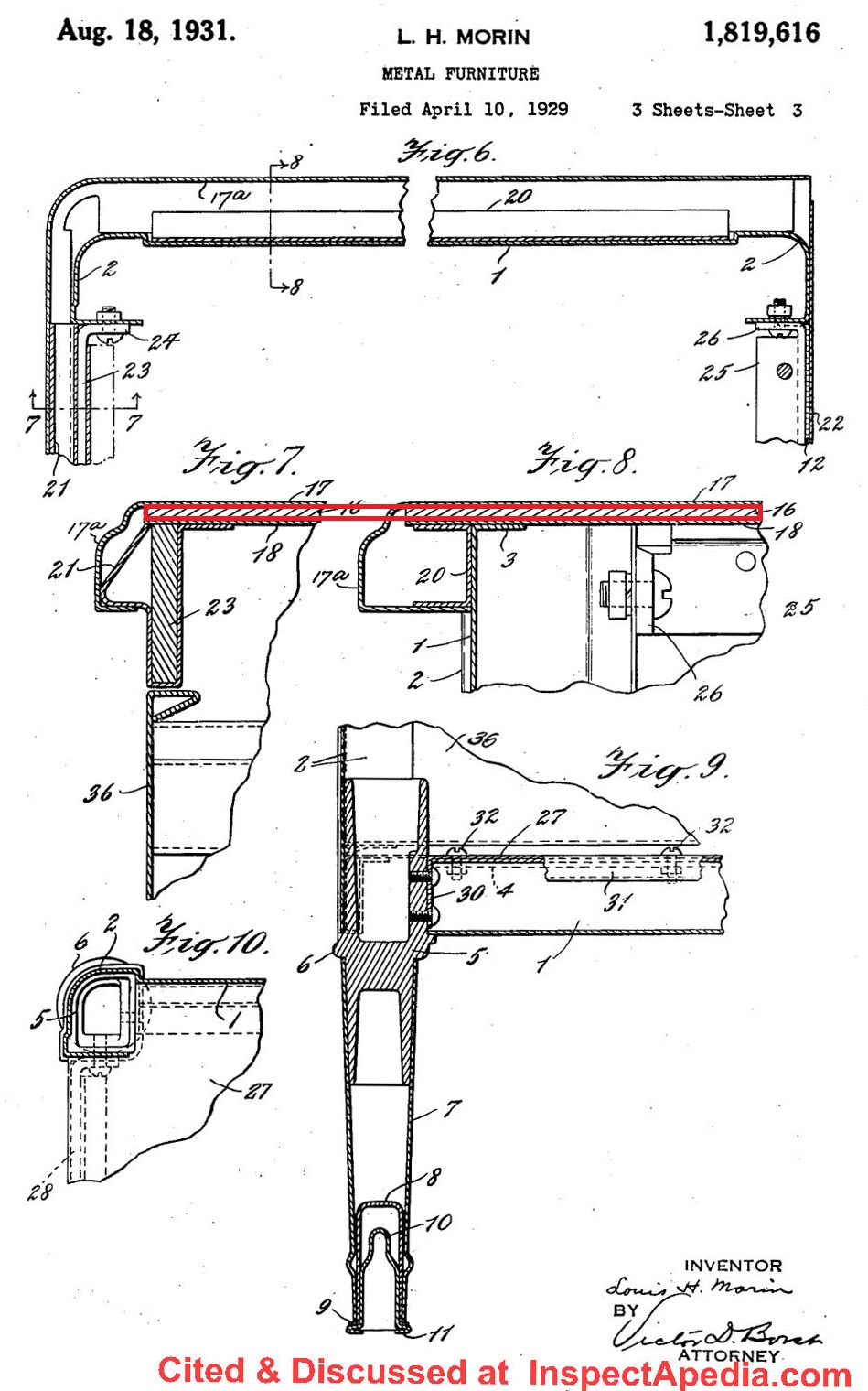
- Asbestos gas fireplace logs & gas fireplace embering materials
- Asbestos glazing compound or asbestos putty for setting glass, mirrors, etc.
- Asbestos gloves were produced for a wide range of applications such as asbestos laboratory gloves and even asbestos gloves for machine gun operators during the Vietnam war.
See ASBESTOS MACHINE GUN MITTENS - Asbestos in hair dryers: Hair dryers containing asbestos were sold by many companies including Clairol, COnair, General Electric, Gillette, J.C. Penny, Montgomery Ward, Norelco, Shick, Sears Roebuck & Co., Sunbeam
- Asbestos in heaters - fireplace mounted heaters, electric heaters, appliances with heating elements. Asbestos or transite asbestos (asbestos-cement) was used in some heating cabinets as an insulating panel and in much smaller format in electric toasters.
- Asbestos in fireplace materials - fire logs,
see ASBESTOS in UNUSUAL PLACES and
also GAS FIREPLACE LOG ASBESTOS
- Asbestos in fireplace materials - fire logs,
- Asbestos in heating ducts or HVAC ducts
See - Asbestos high temperature gaskets
- Asbestos in hospital pads:
Chappelear, David C., Thomas J. Stolki, and Quirino A. Trementozzi. "Polymer foams reinforced with glass or asbestos fibers and process of making same." U.S. Patent 3,474,048, issued October 21, 1969. - Asbestos in incinerators - asbestos was used as internal insulation in trash incinerators
- Asbestos in irons appeared in some products including one iron sold by Sears Roebuck between 1957 and 1958 - source: U.S. Congressional Record, V. 149, Pt. 11, June 20, 2003 to June 19, 2003
See ASBESTOS USE in APPLIANCES
Asbestos was also widely used in iron hot pads or iron supports. Example:
Mercer, Samuel Jesse. "Flat-iron cleaner and polisher." U.S. Patent 1,073,774, issued September 23, 1913.
Excerpt:
Generally speaking, the device consists preferably of a piece of non-combustible material, as tin, having its face or upper surface covered with wire screen.
The opposing surface or bottom of the device may be covered with any suitable material adapted to conceal the raw edges of the wire screen, which are bent at the edges of the tin plate and turned underneath. This bottom covering may consist of asbestos paper, or any other suitable material.
- Asbestos in ironing pads -
Emery, Elizabeth R. ASBESTEOS IRONING PAD [PDF] U.S. Patent 1,402,154, issued January 3, 1922.
Excerpt:
... the device embodying a covering of thin sheet asbestos under which is disposed a pad of blotting paper saturated with a mixture of wax and paraflin or other suitable lubricating substance and both vbeing bound with a binding of gummed paper or tape or cloth ...
Lionel, Dawson Edward, and Taylor Harold. FABRIC PAD for laundry and like presses. [PDF] .S. Patent 2,382,141, issued August 14, 1945.
Excerpt: ... A pad in accordance with this invention comprises a number of layers of open mesh asbestos cloth impregnated with a synthetic resin, and covered by a cover of asbestos cloth ofi-lne quality also resin impregnated and secured to the bottom layer. ...
- Asbestos in ice buckets and asbestos in beverage coolers
Chappelear, David C., Thomas J. Stolki, and Quirino A. Trementozzi. "Polymer foams reinforced with glass or asbestos fibers and process of making same." U.S. Patent 3,474,048, issued October 21, 1969. - Asbestos in ironing boards, various manufacturers, using asbestos based cloth, possibly also asbestos based heat insulating padding.
- Asbestos insulation or asbestos contained in insulation products: an enormous category reflected through the rest of this list;
See ASBESTOS INSULATION - home. Applications of asbestos insulation included- Asbestos Insulation was used in walls and floors (as loose fiber)
- Asbestos Insulation in underground conduits (loose fiber)
- Asbestos High temperature insulation (molded or various types)
- Asbestos Insulation of batteries (loose fiber)
- Asbestos acoustical coating - sprayed asbestos, also
see ASBESTOS FIREPROOFING SPRAY-On Coatings - Asbestos blown-in insulation - including some but not all vermiculite blown-in or loose-fill insulation.
- Asbestos combined with silicone for hot aircraft component insulation is discussed
at ASBESTOS OTHER PRODUCTS.
Also see these asbestos insulation applications: - ASBESTOS BOILER INSULATION
- Asbestos Building Insulation & Asbestos-Contaminated Vermiculite Building Insulation
Asbestos was used directly as an insulating material in building attics, ceilings, walls, commonly in asbestos-containing vermiculite, and more-rarely as raw asbestos material such as installed by Mr. Fluffy in Canberra.
See details at ASBESTOS BUILDING INSULATION
Shown above: corrugated asbestos paper insulation found by the author [DF] in the floor of an attic in a New York home, described
at ASBESTOS in UNUSUAL PLACES
See VERMICULITE INSULATION - Asbestos in Vermiculite Insulation for details about the asbestos hazards, history, and uses of asbestos-containing vermiculite used in a wide range of products and materials. - Asbestos in joint compound: From 1961 to 1977, Bondex joint
compound contained asbestos. cited
at SHEATHING, FIBERBOARD ASBESTOS CONTENT - Asbestos kiln parts, potting kilns, other kilns & heaters, asbestos heat shields & fireproofing used in potters' kilns
- Asbestos lamp sockets
- Asbestos in light bulbs, Light bulbs, lamps, asbestos lamp sockets, asbestos lamp room deodorizers & fragrance dispensers are discussed
at ASBESTOS in UNUSUAL PLACES
and see LIGHT BULB ASBESTOS USE - Asbestos lab hoods and fume hoods probably asbestos fiber cement sheeting. Asbestos panels were also used as lab fume hood exhaust ducting.
- Asbestos lab table tops or countertops as asbestos fiber cement sheeting
- Asbestos lagging paste used as boiler coatings & insulation on heating pipe or water pipe elbows
- Asbestos in light fixtures - asbestos was used as a backing in some incandescent light fixtures, particularly ceiling fixtures.
- Asbestos in lubricants is discussed in detail
at ASBESTOS OTHER PRODUCTS - Asbestos machine gun mittens - used with the Browning AR and possibly other weapons by the U.S. Army including during the Vietnam War. Asbestos-based mittens were used for other heat and fire-protection purposes both in wartime and peacetime such as responding to emergencies of airplane crashes and fires.
See ASBESTOS MACHINE GUN MITTENS for details
- Asbestos mailbags, fireproof - asbestos was used to make fireproof bags used for carrying mail, particularly airmail in the U.S. in the 1930's.
Question: documentation about “mail bags” made by asbestos cloth
1 June 2016 AUTHOR:Nadia (no email)
COMMENT:
my name is Nadia and I am writing from Italy. I am searching for documentation about “mail bags” made by asbestos cloth. Thanking you so much for your interest I send you best regards. Nadia
Reply: asbestos fabric was used to produce fire-resistant bags for airmail transport and possibly other applications -
Nadia:
Asbestos was used in some mail bags, particularly where fire protection was considered important in the U.S. in the 1930's and possibly in Italy or other countries. See these patent research citations
- De, Give Executor Henry L. "Mail bag." U.S. Patent 1,902,764, issued March 21, 1933.
- Jackson, Richard, and H. Wells Jr Edward. "Heatproof container." U.S. Patent 2,087,611, issued July 20, 1937.
- Harold, Bernice Python. "Fireproof mail bag." U.S. Patent 1,811,150, issued June 23, 1931.
- Mudflow, Jr. Samuel, "Air mail receptacle." U.S. Patent 1,970,011, issued August 14, 1934.
- Also see ASBESTOS CLOTH in this article including asbestos-contaminated jute or burlap bags
- Also see ASBESTOS TEXTILES
- Asbestos in mastics & tile or flooring adhesives
See MASTIC, CUTBACK ADHESIVE, FLASHING CEMENT - Asbestos in microwave re-eatable products
Cola sante, David A. "Microwave reheat able clothing and toys." U.S. Patent 5,070,223, issued December 3, 1991.
Excerpt:
toys (including dolls, carryable or huggable objects, renditions of food items, real or fictitious creatures, wearable toys and puppets … of more than one natural or synthetic materials selected from the group consisting of: cotton; cellulose; asbestos ... - Asbestos in mattresses - Asbestos Filling for asbestos mattress insulation. Details are
at ASBESTOS in MATTRESSES.
- Asbestos in medical applications is discussed
at ASBESTOS OTHER PRODUCTS - Asbestos metal protection is described
at ASBESTOS OTHER PRODUCTS - Asbestos millboard, used in stoves, heaters, gaskets, motion picture booths
- See details at ASBESTOS MILLBOARD
- See also ASBESTOS CEMENT PRODUCTS
- Asbestos millboard used in stoves and heaters
- Asbestos millboard used in fire doors, predominantly Chrysotile asbestos
- Asbestos millboard used in garages
- Asbestos millboard used in electric switch boxes
- Asbestos millboard used in garbage incinerators
- Asbestos millboard used in bottoms of brooder stoves
- Asbestos millboard used as fireproof wallboard
- Asbestos millboard used in gaskets, plain and metallic
- Asbestos millboard used in washers in electrical apparatus
- Asbestos millboard used in metal clad doors (between outside metal and wood core)
- Asbestos millboard used in table pads and mats
- Asbestos millboard used in safes
- Asbestos millboard used in motion picture booths
- Asbestos millboard used in dry cleaning machines
- Asbestos millboard used in hoods of automobiles
- Asbestos millboard used in ovens and dry kilns
- Asbestos millboard used as a covering for ceilings above boilers, furnaces, water heaters, smoke stacks, etc. for fire protection -
see FIREPROOFING ASBESTOS SPRAY-ON - Asbestos millboard used in paddles in glass mills
- Asbestos millboard used as fire insulation over heating boilers -
see FIREPROOFING ASBESTOS SPRAY-ON - Asbestos millboard used in tent shields and stove pipe rings
- Asbestos fiber cement roofing shingles and tiles -
see ASBESTOS ROOF MATERIALS - Asbestos fiber cement siding and shingles -
see ASBESTOS CEMENT & FIBER CEMENT SIDING - Asbestos millboard used in stove mats (some may be metal-covered) -
- Asbestos in mobile homes,
trailers (such as this 1981 Sprite Swift Caravan made in the U.K.), doublewides and caravans: asbestos-containing flooring was used in some mobile homes and may have been used in other mobile home components
See ASBESTOS FLOORING IDENTIFICATION 1950's or LATER in the U.K.
- Asbestos used in mortar:
Asbestos fibers and possibly asbestos shorts were used as an additive in mortar for use in brick, stone, or other masonry construction as a fiber-strengthener, to improve water resistance, and to improve fire resistance in specialized construction work.
See details
at ASBESTOS in BRICKS or MORTAR
- Asbestos in nutritional studies
asbestos was used in filters and in other forms for the processing of material samples in studies of food nutrition for humans. (Baker 1977)
Baker, D. "Determining fiber in cereals." Cereal Chem 54, no. 2 (1977): 360-365. Retrieved 2018/08.13, original source: http://www.aaccnet.org/publications/cc/backissues/1977/Documents/Chem54_360.pdf
Excerpt:
... Remove beaker from refluxing apparatus and vacuum-filter hot solution through tared gooch crucible with asbestos mat. ... - Asbestos oil hoses
for oil delivery or in vehicles - Asbestos packing
Asbestos Packing was used for explosives or other materials
Asbestos packing materials used at floor & wall penetrations for piping or electrical wiring in buildings - Asbestos paper
used as insulation, and for gaskets or other applications. See - Asbestos Paints/coatings - asbestos paints, varnishes, fillers, predominantly Chrysotile asbestos; asbestos used for texture, strength, reinforcement or other properties, use of asbestos in paint
includes textured coatings and "popcorn ceiling" paints, also referred to as "cottage cheese" ceilings: acoustic ceiling paints intended to improve noise and sound control in buildings and used to cover irregularities or even to eschew taping drywall joints. .
See ASBESTOS FIREPROOFING SPRAY-ON COATINGS
See CEILING PAINT TEXTURED / POPCORN ASBESTOS
Also see ASPHALT-ASBESTOS PAINT / SEALANT
and see our description of asbestos used in painted coatings described
in ASBESTOS OTHER PRODUCTS.
- Asbestos Paper
was used among a wide range of products such as asbestos felt roofing, stove or heater linings, soldiers helmet linings, electrical appliances, aluminum foil reinforcement for insulation, heating boiler jackets, liners, and duct coverings, gaskets.
Asbestos paper was produced both plain (e.g. used on HVAC ducts and in some furnaces) and corrugated (e.g. used on pipe insulation & in some furnaces)- Asbestos paper backing on vinyl sheet flooring
- Asbestos paper-based acoustical ceiling tile
- Asbestos paper air cell and other pipe coverings
- Asbestos paper appliance heat shielding (toaster interiors, oven interiors, iron pads, ironing board pads)
- Asbestos paper asbestos felt roofing paper
- Asbestos paper duct joint seal and duct insulation on metal ductwork
- Asbestos paper fireproofing used on fire-doors
- Asbestos paper gas burner mats
- Asbestos paper heat shields
- Asbestos paper insulation in the air handler of some furnaces and as a component of hot water or heating pipe insulation
- Asbestos paper lamp socket liners
- Asbestos paper pipe insulation (generally corrugated)
- Asbestos paper protected metal roofing
- Asbestos paper radiator top insulation or heat reflectors
- Asbestos paper roofing felt (asphalt impregnated)
- Asbestos paper stove pipe rings & heat shields
- Asbestos paper (and fabric) tent "garments" or panels or components
- Asbestos paper wick in oil burning apparatus
- Asbestos paper linings of stoves and heaters
- Asbestos paper used to seal metal HVAC duct joints -
see ASBESTOS AIR DUCTS - Asbestos paper linings of filing cabinets, soldiers helmets, automobile mufflers, drum controllers, electric appliances, cartridges, carpets, radiator covers, cookers
- Asbestos paper (corrugated) used to insulate heating piping & water piping -
see ASBESTOS PIPE INSULATION - Asbestos paper (corrugated) used to insulate the interior of some warm air heating furnaces including in the air path or plenum
- Asbestos paper armored car roofs
- Asbestos paper enameling ovens to catch drip
- Asbestos paper diaphragm in electrolytic cell
- Asbestos paper reinforcing aluminum foil for insulation
- Asbestos paper window glass machinery to guide hot sheets; to shield hot glass from flying fragments
- Asbestos paper used in annealing (crumpled paper)
- Asbestos paper covering of rockwool blankets which must be sewed
- Asbestos paper boiler jackets (also asbestos paste lagging used on boilers and on pipe elbows)[DF]
- Asbestos paper built up roofing BUR
- Asbestos paper gaskets, plain and metallic -
see ASBESTOS PACKINGS & GASKETS - Asbestos paper tubes in electrical industry
- Asbestos paper wrapping of hot air ducts or pipes -
see ASBESTOS PAPER DUCT INSULATION
and ASBESTOS INSULATION - Asbestos paper used in or on motors -
see ASBESTOS ELECTRICAL WIRE INSULATION - Asbestos paper insulation of ovens and dry kilns
- Asbestos paper tank covers
- Asbestos paper used in filtering -
see ASBESTOS FILTERS - Asbestos paper used in chemistry and physics in many various ways
- Asbestos reinforced with cotton thread for automobile tops
- Asbestos paper wrapping of wires and cables
- Asbestos paper insulating exhausts on automobiles
- Asbestos paper table pads and mats
- Asbestos paper baking sheets
- Asbestos paper construction of air ducts or lining of paper ducts
- Asbestos paper mache "instant paper mache" products
- Asbestos in parachute apparatus for distributing literature behind enemy lines
Asbestos was used in parachute covers. (Rosato 1959)
Mansfield, Frederick John, Toys or Other Small Devices with Parachutes, US Patent No. US1,3,9,040A, July 8, 1919 -[ Incorrectly cited by Google Search as Planoaraph co. ]
Excerpts:
... New and useful Improvements in Literature-Distributing Devices, of which the following is a specification.
The invention relates to distributing devices and the main object of the invention is to provide a device for scattering literature and dropping things in enemy country.
A distributing device for balloons comprising blocks of literature mounted upon asbestos boards, a rope adapted for attachment to a balloon and having knots, a fuse passing through the blocks of literature and having knots below the asbestos boards, the fuse being attached to the ropes above and below the blocks, and coils in the fuse between the blocks.
Mansfield's invention was later adapted for much larger objects, even vehicles
Francis, Myers George. "Aircraft." U.S. Patent 1,970,812, issued August 21, 1934.
Excerpt: Beneath the chute-is an asbestos board 37, resting upon the top of cartridges 38, which may contain any suitable rapidly expanding medium such as compressed air, explosive or the like. - Asbestos paving materials
in North America from 1960 to 1980 asbestos was used in both fines form as a filler powder and in fibrous form as a strengthener in some road or sidewalk paving materials such as asphalt and concrete.
A benefit of adding asbestos to asphalt or to concrete was its addition of resistance to salt damage in freezing climates where salt was used to melt roadway ice and snow.
In the U.S. New Hampshire closed the door on the U.S. use of asbestos in roadway paving in 1979.
Keep in mind that road asphalt is not readily friable and would not be expected to be a source of high levels of airborne asbestos except possibly to workers involved in the production or application of asbestos-treated asphalt.
Airborne road surface particles of asbestos-reinforced asphalt or concrete may also be released during cutting or sawing of the roadway for repairs or for mechanicals installation below the road surface as well as during demolition (that may include surface grinding) and roadway re-paving.
Other asphalt products such as roofing felt and roof shingles also contained asbestos and are discussed separately in this article series.
Research on the Use of Asbestos in Paving Materials- Busching, Herbert W., and John D. Antrim. "Fiber reinforcement of bituminous mixtures." In Assoc Asphalt Paving Technol Proc. 1968.
- Button, Joe W., and Jon A. Epps. "MECHANICAL CHARACTERIZATION OF FIBER-REINFORCED BITUMINOUS CONCRETE." [PDF] Texas Transportation Institute, College Station, Texas, Report (1981): 4061-1. Retrieved 2018/07/12, original source: https://static.tti.tamu.edu/tti.tamu.edu/documents/TTI-1981-ID19228.pdf
Excerpt:
Particulate fibers used to date include asbestos (3-9), cotton (2) and fiberglass (2). Continuous reinforcement in the form of welded wire, synthetic yarns and fabrics has been used sporadically and in modest amounts in the United States for over 30 years. - Franklin, Marvin L., and Duane W. Gagle. "Synthetic organic fiber {13 asbestos fiber fabric and asphalt impregnated product." U.S. Patent 3,632,415, issued January 4, 1972.
- Kietzman, J. H. "Effect of short asbestos fibers on basic physical properties of asphalt pavement mixes." Highway Research Board Bulletin 270 (1960).
- Putman, Bradley J. "Effects of fiber finish on the performance of asphalt binders and mastics." Advances in Civil Engineering 2011 (2011).
- Also see ASBESTOS in CONCRETE
- Also see ASBESTOS in BRICKS or MORTAR
- Asbestos in phonograph records
- Asbestos piano parts
asbestos was used for piano hammers, soundboards, other parts -
see ASBESTOS in PIANOS - Asbestos pillow cases?
probably not. But see uses of jute to form bags used to transport asbestos, discussed
at ASBESTOS MAIL BAGS and also
see ASBESTOS TEXTILES
Also see ASBESTOS in MATTRESSES
Question: did people make pillow cases out of asbestos transport sacks ?
(May 19, 2016) john said:
I heard that the sacks that were used to transport asbestos were re-purposed because of how soft the material was, into pillow cases.
The story i was told, sacks of asbestos were transported via railroad (turn of the 19th century through the '30s?) and when the asbestos was emptied out for manufacturing a product, the sacks would be thrown away, folks would latch onto the sacks, wash them and then sew them into pillow cases. true?<Reply: no evidence of asbestos pillow cases but jute bags were used to transport asbestos materials
John,
Well that's interesting, or as the Poughkeepsie police told our friend Anna when she said that she thought the cops ought to make the train engineer stop blowing his whistle when approaching the railroad crossing .... "Well that's one I haven't heard before".
I have not found an authoritative source to confirm the asbestos pillow-case legend. Before 1964 when the asbestos industry transported asbestos in sacks the material was jute - hardly something you'd use as a pillow case. Think "burlap bags".
While jute (burlap) would make a nasty pillow case, there are indeed research articles reporting on asbestos hazards associated with re-use or recycling of jute bags that were used for asbestos transport.A search using Google Scholar, for "asbestos pillow case" did not find any research articles on that matter.
And I'm not aware of pillow-case sized sacks used to transport asbestos. Certainly they don't make even a cameo appearance in Rosato's text describing that industry.
Do you think this asbestos pillow-case is more of an urban legend? Or perhaps it's the jute bag asbestos history that fed the pillow case story.
Finally, if you or someone you know has an antique pillow case dating from before 1986 and are nervous about it, I would throw it out.
- Asbestos pipes used as
- Asbestos Ducts - in HVAC systems (cement asbestos, also see transite piping)
- Asbestos Flues & vents, typically for gas fired equipment (cement asbestos, also see transite piping)
- Asbestos Sewer pipe (cement asbestos, also see transite piping)
- Asbestos water pipes (cement asbestos, also see transite piping)
See these articles for details about cement asbestos pipes: - ASBESTOS CEMENT PRODUCTS
- CEMENT ASBESTOS PIPE MANUFACTURE
- TRANSITE PIPE AIR DUCT ASBESTOS RISKS
- TRANSITE CHIMNEYS
- TRANSITE WATER SEWER PIPE ASBESTOS RISK
- Asbestos Pipe insulation
used in mastic and corrugated paper forms on heating and plumbing piping- ASBESTOS PIPE INSULATION
- ASBESTOS PIPE INSULATION FAQs
- ASBESTOS STYROFOAM PANELS
- ASBESTOS FOAMED-OVER describes foam insulation sprayed over and "covering" asbestos material used on piping
- Asbestos in Plaster and stucco,
includes Chrysotile asbestos.
Some plaster products may also contain tremolite (a form of amphibole asbestos) as an inadvertent contaminant from asbestos mining of chrysotile, and also they may include vermiculite that, depending on where it was mined, also contains asbestos (Libby).
Asbestos was also used in plaster casts in orthopedics (asbestos in plaster casts for broken bones), and in medical applications (pleuroectomy), and in a variety of other specialty plaster casts such as shoe lasts.
Details are at ASBESTOS in PLASTER
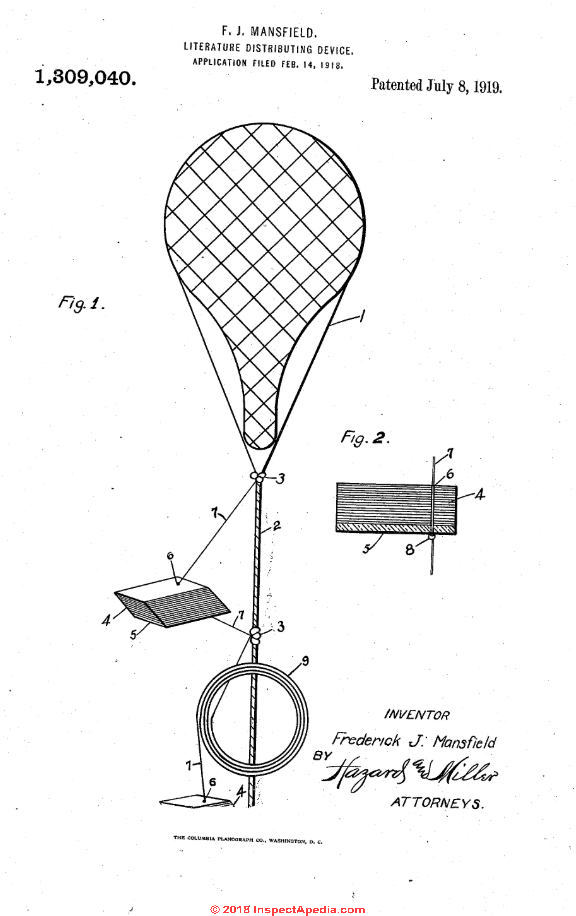
- Asbestos in plastics
asbestos was widely used in a huge range of molded plastics of various formulations.
Plastic asbestos products & manufacturing process are described in detail
at ASBESTOS in PLASTICS.- As reinforcement
- Asbestos Filler in plastics
- Asbestos plastic roof tiles - see these pages from a 1950 catalog
CAREY ROOFING CATALOG 1950 [PDF] describing asbestos plastic roof tiles.
- Asbestos putty
such as window putty and glazing compound was used into the 1960's or later in most countries. - Asbestos Pottery
some human uses of asbestos may be more than 2000 years old. Asbestos flower parts, asbestos used in pottery kilns, asbestos in pottery clays, powders & asbestos in clay glazing & clay coloring products - Asbestos in potting soil
most-likely in asbestos-contaminated vermiculite added to potting soil products
Roy, Ken. "Beware of students bearing kits." Science Scope 33, no. 4 (2009): 56. - Asbestos in Radiant Heat Panels
some radiant heat panel products used asbestos -
see RADIANT HEAT PANEL ASBESTOS - Asbestos, Raw
was used in products such as in asbestos yarn, felt, plastic reinforcements, even in cheese making - Asbestos in Resilient Flooring
asbestos was used, principally in form of chrysotile asbestos, in
See details about poured in place resilient flooring at
POURED-IN-PLACE FLOORING, RESILIENT
also see
Asbestos Resilient Sheet flooring - see
RESILIENT SHEET FLOORING ID GUIDE - home - Asbestos in rockets & rocket motor
parts is described & illustrated at
ASBESTOS in PLASTICS
The space shuttle program in the U.S. used asbestos in a variety of applications.
Example: Hardy, George B. "Space Shuttle solid rocket booster." In American Astronautical Society, Annual Meeting, Los Angeles, Calif., Oct. 29-Nov. 1, 1979, 17 p. 1979.
Excerpt: ... Insulation in the solid rocket motor (SRM) will be provided by asbestos-silica dioxide filled ...
Asbestos containing resilient (vinyl or asphalt) floor tiles -see
ASBESTOS FLOOR TILE IDENTIFICATION - home
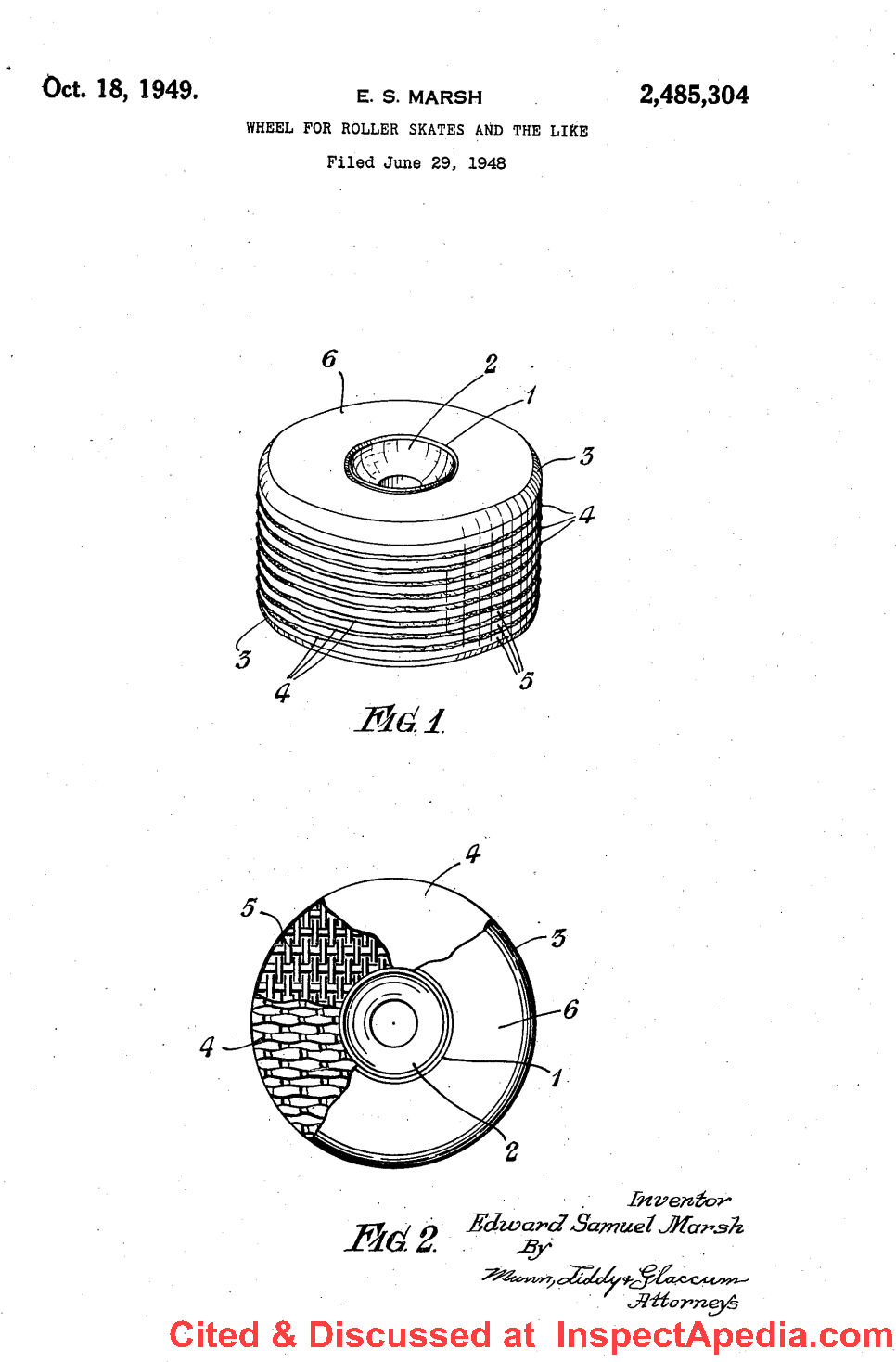
- Asbestos in roller skates, roller skate wheels
Asbestos was used in at least one formulation of composite type roller skate wheels. S(imilar composition type wheels may have been produced for use as rolling furniture casters.)
Samuel, Marsh Edward. "Wheel for roller skates and the like." U.S. Patent 2,485,304, issued October 18, 1949. (sketch shown above)
Excerpt:
There are eight laminations 4 of rubber and seven layers 5 of course weave asbestos fabric impregnated with thermo-setting synthetic resin in the material of the body of the wheel. The asbestos fabric used for these intermediate layers has seven to ten threads to the inch, the threads being woven in a simple warp and weft.
The layers of each kind are arranged alternately and the outer layers 6 which are of similar impregnated fabric or preferably of resin impregnated asbestos fibre boards, are each double in width of those in the middle of the material.
The double thickness of the outer layers may be achieved by using two sheets of fabric in place of the normal one, or by using a fabric of twice the normal thickness, though as stated above the preferred material is resin impregnated asbestos fibre board." - see this patent online at patents.google.com/patent/US2485304A/en - retrieved 2024/07/04, Copy on file as Marsh-Patent-US2485304.pdf
- Asbestos in roofing products
included asbestos cement shingles and asbestos-containing asphalt roof shingles as well as mastics used in roofing as sealants or adhesives. Asbestos also appeared in some insulated roof panels combined with styrofoam.
See- ASBESTOS & FIBER CEMENT ROOFING - home asbestos in fiber cement products used for roofing
- ASBESTOS CEMENT OSHA REGULATIONS
- ASBESTOS CEMENT ROOF & SIDING HISTORY
- ASBESTOS CEMENT SIDED HOME RESALE
- ASBESTOS CEMENT SHINGLE POWER WASH
- ASBESTOS CEMENT SHINGLE REMOVAL
- ASBESTOS FIREPROOFING SPRAY-On Coatings
- ASBESTOS STYROFOAM PANELS
- ASPHALT ROOF MATERIAL ASBESTOS
- Asbestos in Roofing Felt
Morgan, A., B. Stern, G. Hildebrandt, and T. Maugel. "Weather-stabilized asbestos roofing felt." U.S. Patent 3,729,373, issued April 24, 1973.
There is disclosed an asbestos roofing felt sheet with improved dimensional stability under exposure to wheather, and having an increased asphalt saturant-asbestos felt weight ratio, whereby not only weather resistance is greatly improved, but also the speed of machine saturation of the felt with hot liquefied asphalt is greatly increased by virtue of the increased porosity and permeability of the felt.
The sheets consists basically of a very open-mesh skeletal structure of mineral wool fibers which are considerably coarser, longer and more rigid than asbestos fibers, and constitute from about 5% to about 1k% by weight of the sheet, with the balance of the fiber content (from about 70% to about 90% by weight) being chrysotile asbestos.
A small amount (from about 3% to about 6% by weight) of a modified starch constitutes a binder and increases the tensile strength of the felt, and a small amount (from about 4% to about 8% by weight) of an organic fiber is also used to act as a binder for the fibers, and further to increase the flexibility of the felted sheet. A fractional percentage of a surface active agent may be used to provide smoother machine operation and to yield a more uniform felted sheet. - ASPHALT-ASBESTOS FELT
- CORRUGATED CEMENT ASBESTOS ROOFING
- FIBERBOARD ROOFING & FIBER-WOOD ROOFING - home
- MASTIC, CUTBACK ADHESIVE, FLASHING CEMENT - asbestos content in roof flashing & sealant mastics
- Plastic asbestos roof tiles or roof shingles: see
this CAREY ROOFING CATALOG 1950 [PDF] describing Fire-Chex asbestos plastic roof shingles or tiles.
Excerpt: Fire-Chex were found up to 108 times more resistant to fire than conventional shingles. Fire-Chex have a new patented asbestos-plastic coating with highest fire-resistance to guard your home ....
Fire-Chex are the only shingles of any kind to win Underwriters' highest fire-protective rating - Class A - without asbestos underlayment. - ROOF SEALANTS & MASTICS
- ROOFING FELT UNDERLAYMENT REQUIREMENTS
- Asbestos siding
widely used as asbestos cement siding shingles -
See ASBESTOS CEMENT SIDING
Also see CAREY SIDING CATALOG 1950 [PDF] Ceramo ceramic-glazed asbestos-cement siding - Asbestos in road surfacing materials is described
at ASBESTOS OTHER PRODUCTS. - Asbestos Rope -
see ASBESTOS PACKINGS & GASKETS - Asbestos in rubber products as reinforcement, rubber hoses, rubber padding, possibly rubber wire insulation, rubber tires?
See VULCANIZED RUBBER & ASBESTOS PRODUCTS - Asbestos in Sculptures
e.g. mixed in plaster or clay or other materials. - Asbestos in sealants is described
at ASBESTOS OTHER PRODUCTS - Asbestos in Seamless Flooring is described at Poured in place resilient flooring
- POURED-IN-PLACE FLOORING, RESILIENT - Asbestos in ships,
shipping, freighters, asbestos in marine applications was very wide spread from about 1900 into the 1970's or later (Franke 2011).
In part because fire on shipboard is such a serious concern, the list of locations on ships and of other marine uses of asbestos is quite extensive, of which asbestos based flooring and asbestos-insulation on pipes, boilers, and in gaskets were perhaps most-common. - Franke, Kara & Dennis Paustenbach (2011) GOVERNMENT AND NAVY KNOWLEDGE REGARDING HEALTH HAZARDS OF ASBESTOS: A STATE OF THE SCIENCE EVALUATION (1900 to 1970) [PDF], (2011) Inhalation Toxicology, 23:sup3, 1-20, DOI: 10.3109/08958378.2011.643417
- Asbestos in ships lanterns:
(possibly, but no record found to date - July 2016)
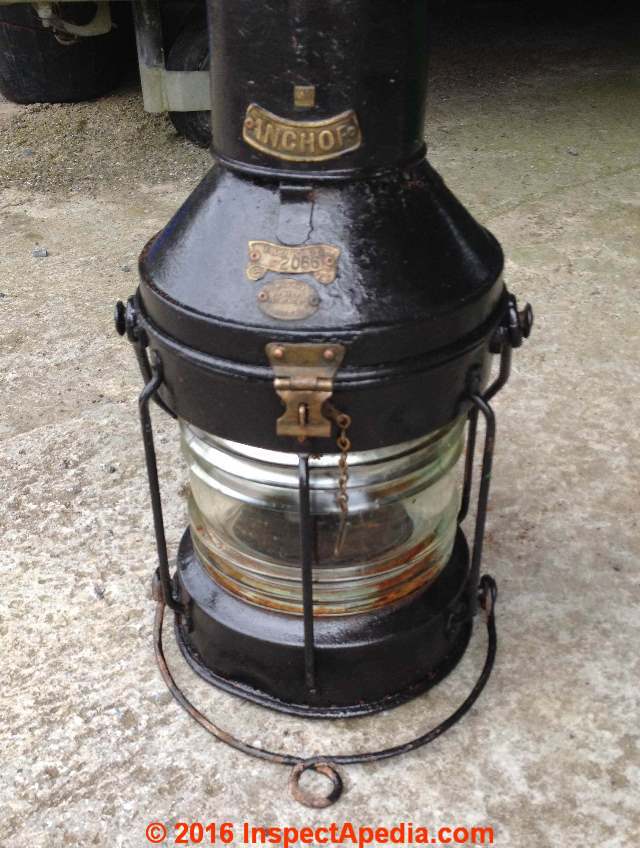
Question: Could old ships lanterns contain a fibrous asbestos product?
2016/07/22 Could old ships lanterns contain a fibrous asbestos product?
I was given a Murray anchor ships lantern (looks like galvanised with brass hinges) which I have been sanding and in the outer annular space at the top, I've pulled out a rusty brown coloured fibrous material.
I don't know the date of manufacture of the lamp, might be early 20th century. do you know whether asbestos was used in these lamps? - Anonymous by email request.
Reply: asbestos in R.C. Murray Ships Anchor lanterns and masthead lanterns ?
Certainly asbestos in form of paste, sealant, paper insulation and rope type gaskets appeared in many old products where fire, air leaks, or heat were concerns.
RC Murray Ships Anchor lanterns were produced in the 1850's and later, in Glasgow, Scotland. I looked at some photos of R.C. Murray Ships Anchor lanterns and masthead lanterns made of copper as well as galvanized steel and didn't see any obvious gasket or heat insulating materials, though the photos won't of course show every component.
If on your RC Murray lantern you see suspect material, you might use the page bottom CONTACT link to send me some sharp photos of the lantern and the parts and components of concern. Photos are not a substitute for a test by a certified asbestos test lab, but together we might recognize other materials.
At www.bl.uk/britishlibrary/~/media/subjects%20images/business/british_patents.pdf you can find information about how to access Scottish patents.
There are patent numbers on some of the RC Murray lanterns; armed with the patent number if you can find the actual patent you can read about the construction and materials used in the lantern as it was originally designed. However you'd have to probably ask for help as the Scottish patents from the 1850's do not appear to be online.
I can't see an obvious asbestos gasket or similar product in your photos [sent later by private email] but I'm not expert on these Lanterns. Asbestos was very widely used in thousands of products where fire resistance was important.
I suspect from the size of the lantern that unless you uses a power tool and inhaled sanding dust, it's not likely that you could have created a substantial concern IF asbestos insulation was in the lamp.
- Harris, John P. "Mantle-support and process for protecting same." U.S. Patent 881,577, issued March 10, 1908.
- Asbestos Siding materials
- ASBESTOS CEMENT SIDING
- ASBESTOS CEMENT SIDING REPLACEMENT
- ASBESTOS CEMENT ROOF & SIDING HISTORY
- Also see CAREY SIDING CATALOG 1950 [PDF] Ceramo ceramic-glazed asbestos-cement siding
- Asbestos skim coats
probably referring to thin coatings of asbestos paint or asbestos paste on surfaces to cover imperfections, to provide a desired texture, or as a fire-resistant coating.
Asbestos was also used to provide body in textured ceiling and wall paints and in spray-on popcorn ceiling paints and coatings. - Asbestos in Solder & Soldering Products
See Asbestos use in solder & soldering products & materials discussed
at ASBESTOS ELECTRICAL INSULATION FAQs - includes asbestos in welding & welding products - Asbestos sound insulating materials
asbestos was included in panels or board products as well as in paints all used as sound isolation or sound transmission reduction products such as asbestos-containing ceiling, wall or floor panels used in construction of buildings and also in vehicles where it was also intended for improved fire protection, such as along with hollow wood floor panels in early aircraft.- Cotts, Ronald F. "Felted inorganic fiber panel." U.S. Patent 3,184,372, issued May 18, 1965.
Excerpt:
Such tiles are currently available for installation in a suspension system which maintains the tiles in a position spaced from an overhead floor assembly. - David, Rubenstein. "Shock absorbing connections for building constructions." U.S. Patent 2,950,576, issued August 30, 1960.
- Fukahori, Yoshihide, Yasuhiro Morimura, Ryota Fujio, and Yukio Fukuura. "Sound damping materials." U.S. Patent 4,461,796, issued July 24, 1984.
- George, Freeman Storm. "Floor and process of laying the same." U.S. Patent 2,026,511, issued December 31, 1935.
Excerpt:
To avoid this difficulty, the invention includes the addition of fiber to the asphalt and cushioning material which may be asbestos fiber, cellulose ... existing as intersecting ribs of mastic extending in both directions of the floor panel, forming a grid of mastic ribs ... - Glaros, Emanuel Michael. "Structural panels." U.S. Patent 3,535,844, issued October 27, 1970.
- Hawkinson, Harold G. "Building construction." U.S. Patent 2,856,039, issued October 14, 1958.
Excerpt:
to assemble a wall panel, a sheet of insulating material 44 such as asbestos is placed in position to completely cover the inside surface of both the inner and outer walls - Kallman, Irwin L, Sofer Uri Y, "Cellular building structure." U.S. Patent 3,577,693, issued May 4, 1971.
- Kloote, George E., "Floor panel for aircraft." U.S. Patent 2,199,938, issued May 7, 1940.
- Murray, Thomas M. "Floor joist damper." U.S. Patent 4,615,157, issued October 7, 1986.
- Ritchie, G. A. C., and W. F. Hesson. "The Moana Pool, Dunedin." New Zealand Engineering 21, no. 1 (1966): 3.
- Willson, Corwin D., "Making molded panels." U.S. Patent 2,674,775, issued April 13, 1954.
- Cotts, Ronald F. "Felted inorganic fiber panel." U.S. Patent 3,184,372, issued May 18, 1965.
- Asbestos spackling compounds & joint compounds or taping compounds
See ASBESTOS in DRYWALL
[Click to enlarge any image]
Above: an advertisement for Keasbey Mattison's sprayed "limpet" asbestos coating. W.R. Grace was a major supplier of Monokote®, a spray-on chrysotile (white asbestos) asbestos coating materials.
- Asbestos Spray Coatings
asbestos including sprayed "limpet" asbestos coatings were used for fire-resistance, fireproofing, soundproofing on building surfaces, pipes, and as an undercoating on sinks and bathtubs.
Monokote® contained varying levels of asbestos from 5 to 50% in the spray coating mixture, typically along with cement, depending on the application.
See ASBESTOS FIREPROOFING SPRAY-On Coatings - spray-on fibers uses as building or structural fireproofing
- Asbestos in storage heater
as noted in the list below, some storage heaters contain asbestos.
ASBESTOS, in the UK, YOUR QUICK GUIDE [PDF] UK Healty & Safety Executive, Web: www.hse.gov.uk/asbestos
The UK asbestos web page includes an offer of a smartphone app that helps list or identify asbestos-containing products.
UK STORAGE HEATERS CONTAINING ASBESTOS [PDF]
PRODUCTS that MIGHT CONTAIN ASBESTOS (in the UK) [PDF] U.K. Health & Safety Executive
Also see
ASBESTOS BOILER INSULATION
ASBESTOS in STORAGE SILOS
NIGHT STORAGE HEATERS & HEAT SINK RADIATORS
- Asbestos Stucco, includes Chrysotile asbestos
- Asbestos in Styrofoam panels & styrofoam insulation
Asbestos materials were sometimes combined with styrofoam panels such a in Zonolite Dyzone™ insulated roof panels or SIPs. See details now found
at ASBESTOS STYROFOAM PANELS
Special thanks to reader E.M. for the photograph of an antique suitcase, 2018/09/27. [Click to enlarge any image]
- Asbestos in Suitcases, Trunks, Briefcases, Valises
Some suitcases and similar products have been described as using asbestos (Thorsrud 1971 and Dvorak 1976).
Details about the use of asbestos in suitcases are given
at ASBESTOS SUITCASES
Above: photo of synthetic "stone" that is obviously fibrous and that may contain asbestos, courtesy of reader Spencer, September 2020
- Asbestos in Synthetic Slate & Stone
asbestos was used as both a filler and as a fibre reinforcement in manufactured slate and stone products, including manufactured slate in the U.S. as early as 1917 -
Saenger, William. "Artificial-stone slab, shingle, and plate and composition for making same." U.S. Patent 1,223,834, issued April 24, 1917. Original Assignee Asbestos Slate Roofing Mfg. Company Inc.
Examples of use of asbestos in synthetic stone & similar products are given in the following: - Bowles, Oliver. Asbestos. No. 403. US Government Printing Office, 1937.
- Eisenberg, Bernard J. "Latex bonded asbestos fiber sheet material." U.S. Patent 3,193,446, issued July 6, 1965.
- Fraass, Albert. "Artificial stone and process of making same." U.S. Patent 1,078,845, issued November 18, 1913.
Excerpt:
Heretofore, artificial stone of this kind has been manufactured by mixing together in a dry state, magnesite, ground wood, asbestos and talc, as well as coloring substances, other mineral substances.
... The process of my invention is carried out as follows Asbestos and talc are added to a solution of chlorid of magnesium and thoroughly distributed throughout the same by mechanically stirring the mixture. To this mixture are added Whatever filling and coloring substances it is desired to use and the whole is stirred so as to cause the added ingredients to be suspended in the solution. - Joseph, Magrath. "Method of making asbestos siding in imitation of brick." U.S. Patent 1,959,960, issued May 22, 1934.
- Parry, Robert E. "Impregnated asbestos product." U.S. Patent 2,101,449, issued December 7, 1937.
Excerpt: After-treatment of mortars, concrete, artificial stone or ceramics; Treatment of natural stone characterised by the material treated. - Poznanski, Mauricy Ignacy. "Process and composition for the manufacture of artificial-stone slabs." U.S. Patent 1,234,692, issued July 24, 1917.
Excerpt: Or dry cement and asbestos are mixed together and the mixture is treated with water and 'molded i115; sllzibs.1 BA third process com(i risesma t esa ina a -en inean the cor'e s ofiheilabsare Ri ht the asbestos fibers taken from a rag-engine, over which cores dr cement powder is spread.
A satisfactory re can be obtained with only the first of the three processes above referred to, but owing to the high price of asbestos it has been often tried to manufacture artificial stone slabs without the use of asbestos or with a mixture of asbestos vegetable fibers, where even a very small excess of water suffices to remove the parvegetablgfibers with cold strong solutions of eta) s 1c so a or fiotashi in order to cause in tioles of cement from the fibers, which have no affinity for the cement.
Animal fibers cannot be used as they are destroyed by free Specification of Letters Patent. - Schulze, Herbert C. "Method of curing articles manufactured from cement and asbestos." U.S. Patent 3,356,779, issued December 5, 1967.
at MANUFACTURED / SYNTHETIC SLATE ASBESTOS CONTENT
Above our lab photograph shows talc particles from Johnson & Johnson's baby powder from a container (also shown above) whose label text was marked ©1996. The red lines indicate the directions of measurement of a large talc particle.
The photograph above was made in in our InspectApedia forensic lab using transmitted light at 1200x and a POLAM microscope. We did not detect asbestos in this talc product.
- Asbestos content in Talc, talcum powder, baby powder.
Asbestos occurs naturally in some talc deposits.
Watch out: Note that talc itself is likely to be a respiratory and health hazard, perhaps due to very small particles in talc used in powders, cosmetics, and other products.
Some scholarly studies by experts, talcum powder might cause cancer in the ovaries if the powder applied to the genital area moves through the vagina, uterus, and fallopian tubes to the ovary. However experts disagree and litigation on the hazards of talcum powder has produced varying judgments to date (July 2018).
Watch out: because talcum powder or talc was used as an ancillary coating on many other products ranging from balloons and bicycle tire tubes to rubber bands and sports equipment, asbestos from the talc source might be found on older versions of those products that have not been cleaned of the powder.
In our OPINION, a rubber band with some talc on it is not likely to provider a detectable airborne asbestos nor talc hazard.
See details
at ASBESTOS in TALCUM POWDER
where we also provide examples
of TALC ASBESTOS in PRODUCTS - Asbestos Tape
was used in products such as oven pull strings, winding electrical bus bars, insulating electrical wires on planes, ships, and in theaters, belts for conveying hot glue or other articles, insulating underground cables- Asbestos tape wick for oil burning apparatus
- Asbestos tape pull strings in ovens
- Asbestos tape insulating armature
- Asbestos tape winding bus bars
- Asbestos tape in laboratory use: insulation for flasks, test tubes, retorts, tie straps in diffusing materials
- Asbestos tape in glass manufacturing for wrapping tines of forks to take bottles from ovens
- Asbestos tape insulating electrical wires on airplanes and ships
- Asbestos tape belts for conveying hot glues or other articles
- Asbestos tape insulating locomotive steam pipes at bends etc
- Asbestos tape used in winding coils
- Asbestos tape insulating underground cables
- Asbestos in Teflon
is discussed under "Electrical Properties of Asbestos-Reinforced Plastics & Molded Products" found at
ASBESTOS PLASTICS - Asbestos in telephones: asbestos was used in telephone cabinets and in telephone boots, typically in transite or cement asbestos form.
- Asbestos Textiles & Fabrics -
see ASBESTOS TEXTILES - Asbestos textured paint
used on ceilings and in some exterior stucco applications. Asbestos was also used in spray-on popcorn ceiling coatings and paints. - Asbestos Theater Curtains & other theater fire smothering
blankets or roducts used in cinemas, performing theaters &c included:
- Asbestos localizing fires in location
- Asbestos wall sections in theater sets to prevent reverberation
- Asbestos firebox in theater fireboxes
- Asbestos blinders or ears for theater lights or sun arcs
- Asbestos dust on cobwebs, old wine kegs, etc.
- Asbestos insulation for maintaining even temperatures
- Asbestos protection of nearby buildings when fires are set
- Asbestos insulation of camera booths against sound
- Asbestos dressing winter scenes as asbestos snow
- Asbestos noise and sound insulation in theaters
- Asbestos theater curtains, predominantly Chrysotile asbestos
- Asbestos theater fireproof walls, using corrugated decorative wallboards
- Asbestos theater flooring
- Asbestos theater electrical wiring -
See ASBESTOS ELECTRICAL WIRE INSULATION
- Asbestos thermal paper products
See ASBESTOS PAPER DUCT INSULATION
- Asbestos Thermos Insulation -
Question: asbestos in British military flask from 1944?
Ant said:
The most-likely material used for a thermos cover would have been canvas, but there is no doubt that some thermos designs, thus possibly including separate thermos covers, contained asbestos from years well before the 1944 date you give and even a bit before the 1925 date you give. Examples of asbestos in early thermos products in both the U.S. and U.K. were found by patent research:
Could you possibly know if these thermos flasks or covers (shown above) contained asbestos either in the main flask or the insulation jacket ?
It is Great Britain 1944 "thermos 1925" flask military issue, many thanks in advance. 2018/09/16
Reply: possibly
Ant
Edward's patent - below - notes that he was a British subject.
Edward, Blackman Arthur. "Temperature-maintaining vessel." U.S. Patent 1,560,375, issued November 3, 1925.
Hyatt, Frank S. "Protective casing for glass bottles." U.S. Patent 1,063,351, issued June 3, 1913.
Excerpt:
The asbestos sleeve and the bottle within it are held securely by coming into contact with the inner surfaces of the apices S of the several concavities formed in the wall of the body of the casing.
Watch out: Other readers beware: we have found reports that a variety of modern thermos flasks made in Asia have been found to contain asbestos, probably as an insulating liner. In those products there should be no asbestos exposure unless the flask is dis-assembled or broken. Brands of thermos flasks believed to contain asbestos include
AB.M IDEA
Acquacalda vacuum flask
ARTE & FUOCO / CASAITALIA
Casa selección
DayDays
EmHome
FoodThermos
Happy Casa
Home
HONG XU JING PIN
Itasco
JIAHE
Neove
Termo Em Home
Thermos HOME - Asbestos Thread
- Asbestos in Toilet Cisterns (toilet tanks) in the U.K.
- some toilet cisterns were made of plastics reinforced with asbestos fibers, a procedure also discussed
at ASBESTOS in PLASTICS.
The black asbestos-containing toilet cistern shown above was illustrated by the U.K. HSE, retrieved 2017/11/10, original source: http://www.hse.gov.uk/asbestos/essentials/floortiles.htm - Asbestos in toys:
cited by Silvestri (2016) and others
Silvestri, Stefano, Francesco Di Benedetto, Corrado Raffaelli, and Angela Veraldi. "Asbestos in toys: an exemplary case." Scandinavian journal of work, environment & health 42, no. 1 (2016): 80-85.
Excerpts:
Objectives DAS was an artificial clay which, once molded, hardened at room temperature. It was largely used as a toy between 1963 and 1975 in Italy, Netherlands, Germany, UK and Norway. This case report describes and reports the presence of asbestos in DAS.
Results The analytical tests confirmed the presence of asbestos fibers in DAS: about 30% of its composition. The documents found at the State Archive confirmed the annual purchase of hundreds tons of raw asbestos from the Amiantifera di Balangero, the Italian asbestos mine. DAS was found to be used also within craftsmanship.
Conclusions Asbestos fibers in DAS may have caused exposure to production workers and a variety of users, including artists, teachers, and children. Over 13 years, about 55 million packs of DAS were produced and sold.
The number of users is difficult to estimate but may have been in the order of millions. In Italy, a specific question on the use of DAS has been included in a routinely used mesothelioma questionnaire.
As DAS was exported to other countries, our findings suggest that mesothelioma patients should be asked about their past use of DAS, in particular individuals not reporting a clear past asbestos exposure. Additionally, this discovery shows the incompleteness of records on asbestos uses and suggests to test items, including toys, imported from countries where asbestos is not forbidden.
Chappelear, David C., Thomas J. Stolki, and Quirino A. Trementozzi. "Polymer foams reinforced with glass or asbestos fibers and process of making same." U.S. Patent 3,474,048, issued October 21, 1969.
This article cites the use of asbestos in polymer plastics used in ... thermal and acoustical insulation, shock-proof shipping containers, ice buckets, beverage coolers, cups, toys, hospital pads, boating equipment, padded dashboards, visors in vehicles, cores for sandwich structures
Also see ASBESTOS in TALCUM POWDER for details of asbestos in children's crayons
- Asbestos transite pipe
See - Asbestos undercoating
Asbestos Automotive body undercoating (auto underbody coating) is described at ASBESTOS OTHER PRODUCTS.
Also see See ASBESTOS FIREPROOFING SPRAY-On Coatings
- Asbestos in vermiculite insulation
Vermiculite insulation contains naturally occurring asbestos fibers in some products, depending on where the vermiculite was mined
- VERMICULITE INSULATION
- ASBESTOS STYROFOAM PANELS - Asbestos vinyl floor tiles
ASBESTOS FLOORING IDENTIFICATION - home - Asbestos vinyl sheet flooring
RESILIENT SHEET FLOORING ID GUIDE - home - Asbestos vinyl wall covering
Asbestos was used as a component in vinyl-based wallpaper in the U.S. as early as about 1920. - Asbestos Wadding
in cartridges and timing devices for explosives - Asbestos wallboard
was used as asbestos cement sheet products used indoors as fireproofing at boiler rooms and other locations.
See ASBESTOS MILLBOARD
See CEMENT ASBESTOS SHEET PRODUCTS
- Asbestos in wallpaper products
Question: does old wallpaper contain asbestos?
2016/08/28 Savannah said:
I live in a 1920s home and noticed the wallpaper detaching from the plaster wall. I started pulling it off put realized it may contain asbestos. Anyone have experience, should I be concerned?
Reply: possibly in special circumstances
Watch out, Savannah. In addition to possible asbestos in some old wall coverings, some old wallpapers, particularly ones with green in the pattern, contained arsenic.
See ARSENIC GREEN in WALLPAPERPreviously we had not specifically listed "asbestos containing wallpaper" in this index to asbestos products, but such products existed, particularly where an insulating or strengthening fiber was wanted or where fire resistance was a concern.
Keep in mind that asbestos may be present in some plaster and gypsum products found beneath wallpaper too.Research citing asbestos use in films and papers used on walls:
- Breiner, R. "Asbestos-plastic film laminates." U.S. Patent 3,770,569, issued November 6, 1973.
- Gerek, Gene, and Rowland S. Hartzell. "Asbestos-foam laminates." U.S. Patent 3,522,140, issued July 28, 1970.
- Lewis, Herman. "Cement composition." U.S. Patent 1,595,897, issued August 10, 1926.
Used asbestos in wall lining products - Newman, Arnold H. "Insulated wallpaper." U.S. Patent 4,039,709, issued August 2, 1977.
- Prain, Willis A., "Wallpaper steamers." U.S. Patent 3,158,139, issued November 24, 1964. (asbestos used in this device not directly in wallpaper)
- SJJ, Langford AL, and Textiles Pearson. "Wallpaper (1827) n. Paper, or paperlike material, usually decorated in colors, which is pasted or otherwise affixed to walls or ceilings of rooms. Wall stress (1) In a filament‐wound pressure." - used atop asbestos cement wallboard
- Werhane, Patricia H., Jenny Mead, Regina Swart, and Mollie Painter-Moreland. "South African Mining and Asbestos-Related Diseases (a)."
Asbestos mining tailings were mixed with cow dung or mud used to paper or line walls in houses.
- Asbestos in washing machines:
appeared in a Sears Roebuck washing machine sold 1957-1958 and possibly other appliances. See citation at asbestos in irons. - Asbestos water heater or hot water cylinder insulation:
may appear as an asbestos lagging, a plaster-like cementious coating, or as a combination of asbestos lagging and corrugated asbestos paper insulation on the cylinder or calorifier as well as on hot water supply piping.
See INSULATE HOT WATER TANK?
See ASBESTOS BOILER INSULATION
Also see ASBESTOS SAFETY CARDS [PDF], U.K. HSE, retrieved 2018/07/29, original source: http://www.hse.gov.uk/asbestos/assets/docs/beware-asbestos-reference-cards.pdf - Asbestos water tanks: in the U.K. an cement-asbestos water cistern or water tank was sold under the brand Eternit siciliana.
- Asbestos in welding:
- Asbestos Coating for welding rods
- Asbestos clothing to protect welders
- Asbestos welding blankets or asbestos cloth or padding to protect nearby objects from heat during welding
See ASBESTOS in BLANKETS - Asbestos welding mask components
Asbestos used in welding rods is described
at ASBESTOS OTHER PRODUCTS. - Asbestos wick packing
was used as packing for piping, wire, armor plate, galvanized materials- Asbestos wick packing
- Asbestos wick packing used in piping of wire, armor plage, or galvanized materials
- Asbestos window putty
watch out old window putty may also contain hazardous levels of lead - Asbestos in wine making
for clarifying filters - see detail
at ASBESTOS FILTERS - Asbestos in wood putty & hole fillers
there were some nail-hole and screw-hole fillers that contained asbestos such as some plaster or joint compounds used to fill holes in drywall, and apparently older versions of some products still sold today such as Dum Dum nail hole filler (sold in various colours), and some masonry block fillers and sealants made by several companies including Bondex and Sherwin Williams.
- Asbestos in woodburning stoves -
typically in the form of asbestos rope gaskets at stove doors, possibly in other forms - Asbestos combined with wool felt pipe insulation
Hurrell, Elmer S. "Thermal insulation and method of making the same." U.S. Patent 2,016,039, issued October 1, 1935. Original Assignee Johns Manville.
Excerpt: A preferred embodiment of the invention is magnesia pipe covering to the outer surface of which is adhesively secured a thin sheet of wool felt with a sheet of asphalt-impregnated asbestos paper adhesively secured to the outer surface of the wool felt. - Asbestos yarn, wick packing, felt, rollboard, insulating wire,
85% Magnesia pipe covering, blocks and locomotive lagging - Asbestos yarn fabrics
were in turn used to produce woven fabrics used in other products such as asbestos cloth, lining, steam hoses, even spark plugs- Asbestos Cloth, lining, packing, valve stem braided and other
- Asbestos Wick for oil burning apparatus
- Asbestos filters used in industrial processes for removing particulates from liquids including wine, predominantly Chrysotile asbestos -
see ASBESTOS FILTERS - Asbestos Gaskets and gasket cloth, predominantly Chrysotile asbestos form -
see ASBESTOS PACKINGS & GASKETS - Asbestos Twine or sewing thread
- Asbestos Electric fixture wire covering
- Asbestos Typing gas mantles
- Asbestos Edges for hair felting
- Asbestos Fire retardant hose
- Asbestos Tape, electrical and other
- Asbestos Clutch facings, predominantly Chrysotile asbestos -
see ASBESTOS FRICTION MATERIALS - Asbestos Gas mask filters
- Asbestos Tubing
- Asbestos packing and sealants used in motors to seal at rotating shafts, predominantly Chrysotile asbestos
- Asbestos Rope
- Asbestos Stocking for lead cable
- Asbestos Electric cable covering
- Asbestos Spark plugs
- Asbestos Steam hoses
- Ripper, Kurt E. ASBESTOS YARN [PDF] U.S. Patent 2,318,560, issued May 4, 1943.
Excerpt: ... my asbestos yarn are useful as electrical insulation, in the fabrication of flame proof clothing, ... - See ASBESTOS PACKINGS & GASKETS
and ASBESTOS TEXTILES and
also ASBESTOS in MATTRESSES
...
Reader Comments, Questions & Answers About The Article Above
Below you will find questions and answers previously posted on this page at its page bottom reader comment box.
Reader Q&A - also see RECOMMENDED ARTICLES & FAQs
On 2023-07-12 by Anonymous - sbestos in incontinence medical products?
Hi, I use incontinence products on a daily basis. The other day I accidentally got the sticky tape stuck together and in the process of fixing it I ripped one open.
I saw inside what felt like a gritty and sandy like filler mixed in together with the cotton filling.
There was so much of it too. I couldn't believe it. I opened up another one from a different manufacturer, one I have used alot and their's did not have that stuff in it.
The company with the gritty inside filler claims on the label that it helps with maximum absorbancy, but all I could think of was this stuff is getting inside my body and I want to know what it is. I have been having a bad rash and severe itching while using them.
When I switched back to the brand I normally use that didn't have the gritty stuff in it my symptoms started to go away. My question is could this gritty/sandy-like stuff in the cotton filling be asbestos or wood fibers? Do you know anything about these types of products please? Do you know who I can contact to find out for sure? Thank You!
Reply by InspectApedia Publisher (mod) - no asbestos in modern incontinence or similar medical products
@Anonymous,
You will not find asbestos used in any form in modern medical products.
On 2023-06-05 by Anonymous - last use of asbestos fire curtains in theaters?
Do you know when they stopped making asbestos fire curtains and what the friability of such curtains are when they are literally just hanging out above a stage? Thanks
Reply by InspectApedia Publisher (mod) - when they stopped making asbestos fire curtains
@Anonymous,
The "last production date" for asbestos-containing fire curtains - if you mean theatre curtains - varies by country; for example in the U.S. that'd be sometime at or before 1986. Most of the references we've researched for this question put the last production of asbestos fabrics in the U.S. in the late 1970s.
Other asbestos fabrics that might have been called "curtains" or "blankets" were used by firefighters.
"Friable" means that you can crumble a material to a powdry dust simply by smashing it between your thumb and forefinger. Certainly you're not likely to be able to do that with a theatre curtain.
But a reasonable question might be how much fibre shedding occurs from undisturbed theatre curtains. Answering without specific information about the site, building, conditions, and curtain, would be so speculative as to simply not be useful.
On 2023-03-04 by M reser - use of asbestos in plumber's putty?
In 1960’s/1970’s/1980’s did plumbing sealants eg. Flux and putty and boswhite contain asbestos when used in the UK
On 2023-03-04 by InspectApedia Publisher (mod) - yes there is possible use of asbestos in older plumber's putty
@M reser,
Some such products did contain asbestos.
Use your browser's on-page search feature (such as Ctrl-F) and search this page for the word
putty
to see eight examples of putty products that contained asbestos, so asbestos might indeed have been present in some plumbing sealants as well.
However so far our research hasn't turned up specific plumbers putty brands with asbestos. In any event unless the material is dry and crumbles to powder, it's not friable.
On 2023-02-08 by Brian - asbestos in an old Hoover Vacuum Cleaner?
I was cleaning out an old vacuum. At first thinking I was cleaning out a bunch of dirt fibers then realized it was and old filter not until I was done did I think of assp should be an asbestos filter that I was digging up. And that's only cuz I'm old enough to know that.
And it's an old vacuum. But it worked really well and I never imagined it having asbestos in it. I'll attach a picture
The vacuum is a Hoover the stuff on top is what I dug out of the filter from the bottom of the vacuum which I thought was dirt at first then it crossed my mind it could be a filter but not till I was done did I think oh s*** what if it's asbestos this was the same vacuum I had used when I was in elementary school and I'm 57 now. Exact same vacuum so it's at least from early seventies if not older probably older
On 2023-02-08 by InspectApedia Publisher (mod) - research has not found evidence that asbestos was used in old Hoover Vacuum Cleaners
@Brian,
What made you believe that the old Hoover vacuum cleaner's filter used asbestos? Have you found any documentation that suggests that use? If so do let us know.
I've researched the question "Was asbestos ever used in the construction of vacuum cleaner filters?" without finding any such reference, though I note that it's difficult to phrase that search question, even among patent research, without being flooded with articles about the *use* of HEPA vacuum cleaner filters for cleaning up asbestos dust and debris.
On 2023-02-12 by Valerie K
Our 1956 walk-in attic space contains some wall paper which appears very old.
I am wondering if it may contain asbestos as it is falling apart significantly. In some areas the wallpaper is peeling off in sheets.
In other areas it cracks or chips. It is thick with a brown backing that is smooth and not at all sticky. Would this wallpaper have the potential to contain asbestos?
On 2023-02-12 by InspectApedia Publisher
@Valerie K,
1950s Wallpaper in residential buildings would not be an asbestos product.
...
Continue reading at ASBESTOS IDENTIFICATION IN BUILDINGS or select a topic from the closely-related articles below, or see the complete ARTICLE INDEX.
Or see ASBESTOS PRODUCT FAQs - questions and answers posted originally at this page
Or see these
Recommended Articles
- ASBESTOS PRODUCING COMPANIES & TRUSTS for a most-complete list of companies that produced products containing asbestos
- ASBESTOS PHOTO GUIDE to MATERIALS
- ASBESTOS PRODUCTS BANNED vs PERMITTED U.S. 2023
- ASBESTOS TESTING LAB LIST and also
- DUST SAMPLING PROCEDURE
- ASBESTOS IDENTIFICATION IN BUILDINGS
- ASBESTOS PRODUCTS 1959 - returns to the chapter in ASBESTOS ORIGIN & NATURE where Rosato's Table 1.7 originally appeared.
- ASBESTOS PRODUCTS in the UK, LIST [PDF]
- Table 1.7. ASBESTOS APPLICATIONS -1959 - this is a separate PDF file that provides the original Asbestos Applications Table 1.7 from Rosato (1959) [1] from which the web article above was adapted.
- "16 CFR Chapter 11, CONSUMER PRODUCTS CONTAINING ASBESTOS,ADVANCE NOTICE OF PROPOSED RULEMAKING", [PDF] U.S. Consumer Products Safety Commission, CPSC, U.S. Federal Register, Vol. 44. No 201, 17 October 1979, Proposed Rules, 60057. This document cites a long list of consumer products that contained asbestos.
- ASBESTOS ENVIRO-SCARE The Normal Curve Cycle of Public Fear of Environmental Issues
- ASBESTOS-CONTAINING DUST from the WORLD TRADE CENTER COLLAPSE following the 9/11/01 attack: the lower floors of this building contained spray-on fire-proofing asbestos materials.
- DOES THIS MATERIAL CONTAIN ASBESTOS? - 5 easy questions to tell if a BUILDING MATERIAL probably contains asbestos -
- EPA Sample List of ASBESTOS CONTAINING MATERIALS [PDF] at InspectApedia.com
- TEST CUTS for SAMPLING BUILDING MATERIALS
Suggested citation for this web page
ASBESTOS LIST of PRODUCTS at InspectApedia.com - online encyclopedia of building & environmental inspection, testing, diagnosis, repair, & problem prevention advice.
Or see this
INDEX to RELATED ARTICLES: ARTICLE INDEX to ASBESTOS HAZARDS
Or use the SEARCH BOX found below to Ask a Question or Search InspectApedia
Ask a Question or Search InspectApedia
Questions & answers or comments about what building products and common in-building products, appliances, mechanical components were produced using asbestos materials.
Try the search box just below, or if you prefer, post a question or comment in the Comments box below and we will respond promptly.
Search the InspectApedia website
Note: appearance of your Comment below may be delayed: if your comment contains an image, photograph, web link, or text that looks to the software as if it might be a web link, your posting will appear after it has been approved by a moderator. Apologies for the delay.
Only one image can be added per comment but you can post as many comments, and therefore images, as you like.
You will not receive a notification when a response to your question has been posted.
Please bookmark this page to make it easy for you to check back for our response.
Our Comment Box is provided by Countable Web Productions countable.ca
Citations & References
In addition to any citations in the article above, a full list is available on request.
- 16 CFR Chapter 11, Consumer Products Containing Asbestos, Advance Notice of Proposed Rulemaking", [PDF] U.S. Consumer Products Safety Commission, CPSC, U.S. Federal Register, Vol. 44. No 201, 17 October 1979, Proposed Rules, 60057. This document cites a long list of consumer products that contained asbestos.
- ASBESTOS (CHRYSOTILE, AMOSITE, CROCIDOLITE, TREMOLITE, ACTINOLITE AND ANTHOPHYLLITE) [PDF] IARC Working Group on the Evaluation of Carcinogenic Risk to Humans. in Arsenic, Metals, Fibres and Dusts. [Book as PDF] Lyon (FR): International Agency for Research on Cancer; 2012. (IARC Monographs on the Evaluation of Carcinogenic Risks to Humans, No. 100C.) Available from: https://www.ncbi.nlm.nih.gov/books/NBK304374/
Published by the International Agency for Research on Cancer, 150 cours Albert Thomas, 69372 Lyon Cedex 08, France ©International Agency for Research on Cancer, 2012 Distributed by WHO Press, World Health Organization, 20 Avenue Appia, 1211 Geneva 27, Switzerland (tel.: +41 22 791 3264; fax: +41 22 791 4857; e-mail: bookorders@who.int). - Archer, S. R., and T. R. Blackwood. Status assessment of toxic chemicals: asbestos. Vol. 1. Environmental Protection Agency, Office of Research and Development, Industrial Environmental Research Laboratory, 1979. In this text, table 4. U.S. Asbestos Uses (3)
This book is available as a free e-book via Google Play. Link:
https://play.google.com/books/reader?id=U57ObCey-wcC&printsec=frontcover&output=reader&hl=en&pg=GBS.PP1 - ASBESTOS HISTORY & PROPERTIES [Book online] D.V. Roasato, engineering consultant, Newton MA, Reinhold Publishing Co., NY, 1959, Library of Congress Catalog No. 59-12535. We have re-published this text as an online book at InspectApedia. Excerpts & adaptations are also found in InspectApedia.com articles on asbestos history, production & visual identification in and on buildings.
- "Asbestos in Plastic Compositions", A.B. Cummins, Modern Plastics [un-dated, pre 1952]
- "Asbestos in Your Home," Spokane County Air Pollution Control Authority, Spokane WA 509-477-4727 www.scapa.org provides a one-page image, a .pdf file drawing of a house warning of some possible sources of asbestos in the home. The sources are not ranked according to actual risk of releasing hazardous levels of airborne asbestos fibers and the list is useful but incomplete.
- Camplin, Jeffery C. "Asbestos, Second wind" brings contaminant back into public eye [PDF] Professional Safety 48, no. 8 (2003): 32-39.
Includes "Piano felts" among list of asbestos cloth and woven products. - retrieved 2020/01/28 original source: https://pdfs.semanticscholar.org/6040/ad3f90377173c4acb3fedd6a440edf7a83b6.pdf - Chrysotile [asbestos] and Its Uses, Louis Perron, Minerals and Metals Sector, Canadian Minerals Yearbook, 2002, Natural Resources Canada, web search 03/01/2011, original source: http://www.nrcan-rncan.gc.ca/mms-smm/busi-indu/cmy-amc/content/2002/20.pdf
- The US EPA provides a sample list of asbestos containing products epa.gov/earth1r6/6pd/asbestos/asbmatl.htm
- Thanks to Susan Kimball, Argus Pacific Corp., Puget Sound, WA, for pointing out that some products are permitted to contain more than 1% asbestos fibers by current standards provided that the fibers are encapsulated in an appropriate binder. Argus Pacific, in Seattle, WA 98119, 206.285.3373, is an industrial hygiene firm who also provide OSHA and DOSH regulated training in Washington State, providing classes in asbestos, lead, mold, hazardous waste, emergency response, and other occupational health, safety, and professional development topics. -- September 2008.
- " Work Practice for Window Removal and Window Putty Patching With Less Than Or Equal To 1% Asbestos Window Putty and Caulking" University of Washington, 2002 http://www.washington.edu/admin/asbestos/1putty.html
- How do I Manage Asbestos in our House or Apartment Building?, Illinois Department of Environmental Conservation, provides this article at http://www.epa.state.il.us/small-business/asbestos-in-home/
- Asbestos in buildings - employee notice, University of Washington dept. of Environmental Safety, http://www.ehs.washington.edu/ohsasbestos/index.shtm
- Window putty to be exempted from asbestos removal by State of Maine - http://list.uvm.edu/cgi-bin/wa?A2=SAFETY;wYpdKg;20010307113643-0500A
- EPA Region 6 identifies window putty as asbestos containing - http://www.epa.gov/earth1r6/6pd/asbestos/asbmatl.htm
- OSHA Window Putty - OSHA case cites contractor for asbestos exposure during removal of window putty http://www.osha.gov/pls/oshaweb/owadisp.show_document?p_table=NEWS_RELEASES&p_id=1091
- Asbestos Identification and Testing References
- Asbestos Identification, Walter C.McCrone, McCrone Research Institute, Chicago, IL.1987 ISBN 0-904962-11-3. Dr. McCrone literally "wrote the book" on asbestos identification procedures which formed the basis for current work by asbestos identification laboratories.
- Stanton, .F., et al., National Bureau of Standards Special Publication 506: 143-151
- Pott, F., Staub-Reinhalf Luft 38, 486-490 (1978) cited by McCrone
- ASBESTOS IN YOUR HOME U.S. EPA, Exposure Evaluation Division, Office of Toxic Substances, Office of Pesticides and Toxic Substances, U.S. Environmental Protection Agency, Washington,D.C. 20460
- Asbestos products and their history and use in various building materials such as asphalt and vinyl flooring includes discussion which draws on ASBESTOS, ITS INDUSTRIAL APPLICATIONS, ROSATO 1959, D.V. Rosato, engineering consultant, Newton, MA, Reinhold Publishing, 1959 Library of Congress Catalog Card No.: 59-12535 (out of print, text and images available at InspectAPedia.com).
- EPA ASBESTOS MATERIALS BAN: CLARIFICATION 1999
- "Handling Asbestos-Containing roofing material - an update", Carl Good, NRCA Associate Executive Director, Professional Roofing, February 1992, p. 38-43
- EPA Guidance for Controlling Asbestos-Containing Materials in buildings, NIAST, National Institute on Abatement Sciences & Technology, [republishing EPA public documents] 1985 ed., Exposure Evaluation Division, Office of Toxic Substances, Office of Pesticides and Toxic Substances, U.S. Environmental Protection Agency, Washington,D.C. 20460
- Lindell K. 1973. Industrial uses of asbestos. Biological effects of asbestos. In: Bogovski P, Trimbrell V, Gilson JC, Wagner JC, eds. Proceedings of a Working Conference held at the International Agency for Research on Cancer, International Agency for Research on Cancer (IARC) Scientific Publication No. 8. Lyon, France.
- Gallant, Tim, "Asbestos General Awareness Training for School Custodial and
Maintenance Staff" [PDF] Maine Department of Enviornmental Protection,
This training guide was prepared with information found in “How to Manage Asbestos in School Buildings: The AHERA Designated Person's Self Study Guide”, EPA, 1996, the Environmental Safety and Health Online, and OSHA. - Rosato, D.V., Asbestos, its Industrial Applications, D.V. Rosato, engineering consultant, Newton MA, Reinhold Publishing Co., NY, 1959, Library of Congress Catalog No. 59-12535. Excerpts & adaptations are found in InspectApedia.com articles on asbestos history, production & visual identification in and on buildings.
Re-printed online with additional annotations, photos, and information, beginning at ASBESTOS, ITS INDUSTRIAL APPLICATIONS, ROSATO 1959 - Rushworth D. 2005, Spring. The Navy and asbestos thermal insulation. Naval Eng J 117:35–48.
- US Department of Defense. 1954, August, 16. Military specification: technical manuals for mechanical and electrical equipment, MIL-T-15071 B(SHIPS). Washington, DC: US Department of Defense.
- US Navy. 1941b. Bureau of ships ad interim specification; gaskets, boiler, metallic-asbestos, spiral wound. Washington DC: Bureau of Ships.
- US Navy. 1945. Bureau of Ships Manual, Chapter 39, Thermal insulation.
CONTINUE READING or RECOMMENDED ARTICLES.
- Carson, Dunlop & Associates Ltd., 120 Carlton Street Suite 407, Toronto ON M5A 4K2. Tel: (416) 964-9415 1-800-268-7070 Email: info@carsondunlop.com. Alan Carson is a past president of ASHI, the American Society of Home Inspectors.
Thanks to Alan Carson and Bob Dunlop, for permission for InspectAPedia to use text excerpts from The HOME REFERENCE BOOK - the Encyclopedia of Homes and to use illustrations from The ILLUSTRATED HOME .
Carson Dunlop Associates provides extensive home inspection education and report writing material. In gratitude we provide links to tsome Carson Dunlop Associates products and services.


